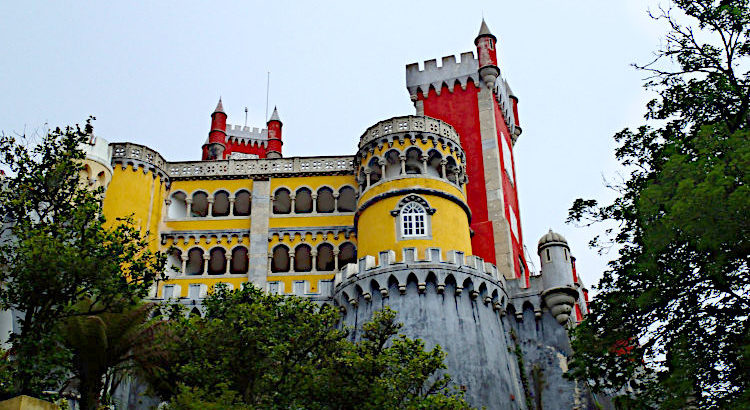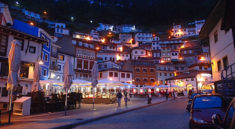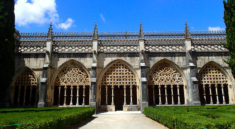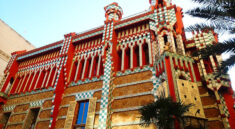
Sintra is amazing – but it’s also manically busy, especially from Easter to September. So we’ve combined our trip diary from our visit (and just a tiny fraction of the hundreds of photos we took) with tips and advice so that if you ever visit, you can be prepared to make the best of your day and save cash and time.
How to get around the Sintra Palaces
Everything we read up in advance recommended getting the 434 or 435 tourist buses. These are hop-on-hop-off but the trouble is you can only do one circuit in one direction with the regular ticket, so you HAVE to visit the sites in the order of the bus stops (along with everyone else). Or pay again to visit out of order.
When we visited it was €6.90 per person for the 434 to go from the train station, to the historic centre and the Sintra Palace, then the Moorish Castle, then Pena Palace and then back to the train station. So if you want to visit Pena first, then the Sintra Palace, you would have to buy two tickets – daft isn’t it. It should include hop on hop off travel all day – there is an option for that but it costs €15 per person.
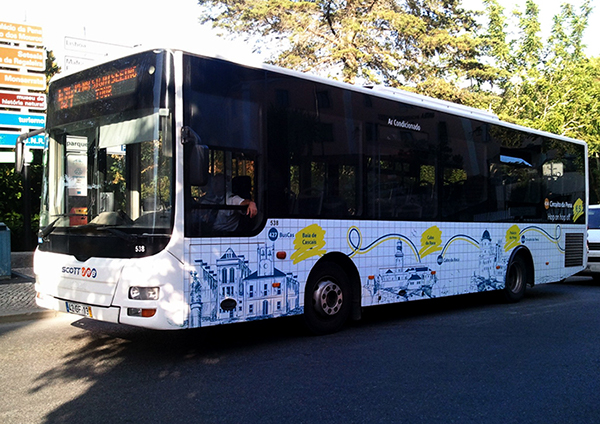
The buses are very crowded, usually standing room only, very hot, you have to wait in the sun for the next bus and it if it full, it will just keep on going and not stop.
And what if where you are staying isn’t close to the bus station? Then you either have to walk there or catch another bus or taxi just to get to the start of the tourist bus route. Even with just two people it gets expensive. So our recommendation is to skip the bus and take an Uber!
Yes, getting around in the air-conditioned comfort of a private taxi is faster, nicer, more convenient and cheaper than the hot, slow, overcrowded tourist bus! You couldn’t make it up. We took an Uber from our out-of-town camper parking up to the Pena Palace for less than €5.00 for the both of us. Getting home again from the Sintra Palace was even less. Door to door 🙂

We’re quite new Uber users, and if you’ve not done it yet, don’t worry, it’s REALLY easy! You just pick where you want to go on the map or by name, the taxi is assigned, you can see it coming to pick you up in real time on the map and they already know where you want to go. So in foreign countries where you can’t speak the language – it’s perfect! You know you won’t get ripped off and everything is so easy and hassle-free. We’ve got an intro code for you which will give you £3.00 off your first trip when you sign up with this link. JOIN UBER HERE
Ticket tips – buy in advance!
For Day 1 of this itinerary, we bought our tickets online in advance. It’s already busy so you don’t want to waste time queuing to buy tickets and then queuing again to get in. You get a 5% discount on the ticket price by pre-booking, and then the ticket can be downloaded to your phone, or printed as a paper ticket and scanned at the gate. No need to get in two queues.
Buy at the official Sintra Website here.
Tickets online are valid until the end of the year; you don’t need to book a particular date.
For the second day, these sites aren’t so busy and we were able to buy tickets on arrival without any queue. You can still pre-buy them online to get the small discount.
Day 1 – Pena Palace, Moorish Castle and Sintra Palace
These are the most visited sites so be prepared for your day to be busy today. The tourist hop-on-hop-off bus 434 only goes in one direction and you can only ride it in that direction once, so most people visit the Sintra Palace, then the Moorish Castle and then Pena Palace in that order. Or skip Sintra and visit the Moorish Castle and then Pena.
You can beat (some) of the queues at Pena and give yourself a head start over the coach parties by doing it in the reverse order. So either get the bus or a taxi/Uber to Pena Palace to start your visit. It will still be fairly busy when it opens at 9:30, but by 10:30-11:00 the queues will be much longer.
We took our Uber right to the Pena Palace gates as our first visit of the day.
Pena National Palace
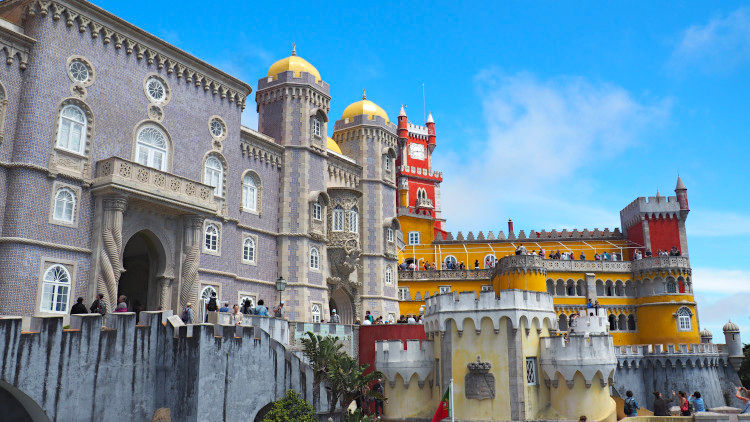
Built at 500 meters altitude and inspired by the palaces of Bavaria, the Pena Palace is the most beautiful example of the Portuguese architecture of Romanticism, for its extremely fanciful features. Its construction dates back to 1839, when King Ferdinand II of Saxe Coburg-Gotha acquired the ruins of the Jerome Monastery of Our Lady of Pena to transform it into a ‘small’ palace.
Ticket types for the palace. There are two tickets you can buy for the palace. A park only ticket for the outside and also a full ticket which allows time inside the palace. We bought the combined ticket and we did enjoy it because we don’t get to visit this sort of site very often. However, at €7.50 for the park ticket and €14 for the combined, the park is defintely better value. You could skip the inside tour of the palace (where most of the crowds are) and enjoy more time on the grounds.
From the entrance, climb up through the gardens, and follow the signposts to the palace. There is a hop-on-hop-off bus that runs within the palace grounds but the queues are long, and you’ll miss out on the lovely grounds inside a bus. If you have mobility issues, take the bus, but otherwise, walk up to the palace and admire the views.
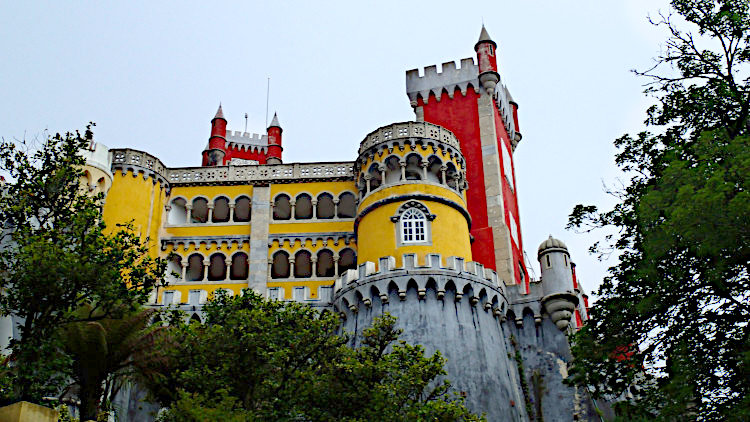
Through an impressively decorated arch and up through a short tunnel and you’ll emerge onto the terraces in front of the palace main facade. Now you can admire the beautifully decorated tiles, the Gothic architecture, the bright colors Pena is renown for, and be welcomed by this guy scowling down at you!
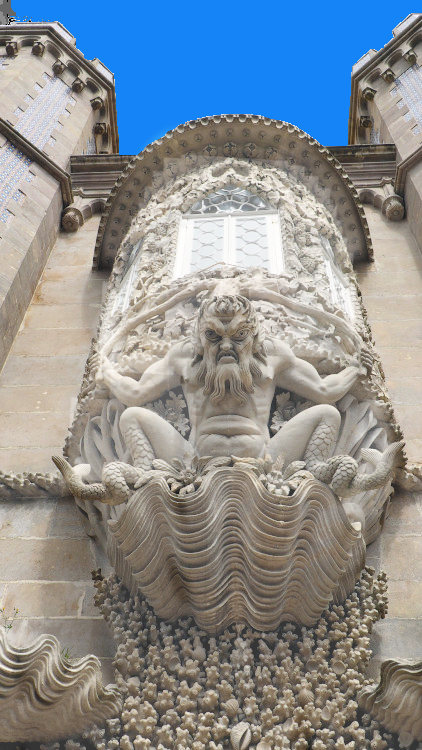
This is a great place to spend some time admiring the view and there is a cafe with sandwiches and cakes. When we visited, it was a very windy day. One side of the terrace with sunnier and warm and the other side was very exposed to the wind and much colder.
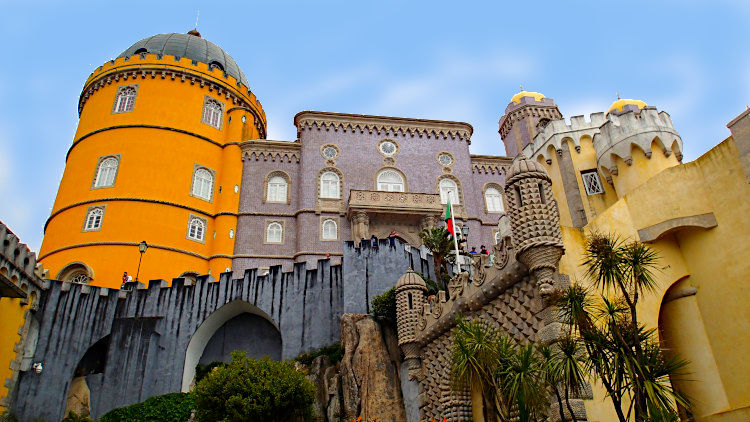
The weather at the very top of the hill is ‘interesting’. It’s right up in the clouds, so much so that you feel you are on the same level and could reach out and touch them. Sometimes a cloud would literally float through the palace area and it would be like a sudden cold fog had descended. It is for the cool fresh air that the royals and nobility enjoyed spending time in these high palaces in Sintra during the hot summer months. But be aware that you will need a jumper, or even a coat because its colder up here than down in the town, and colder than you might expect.
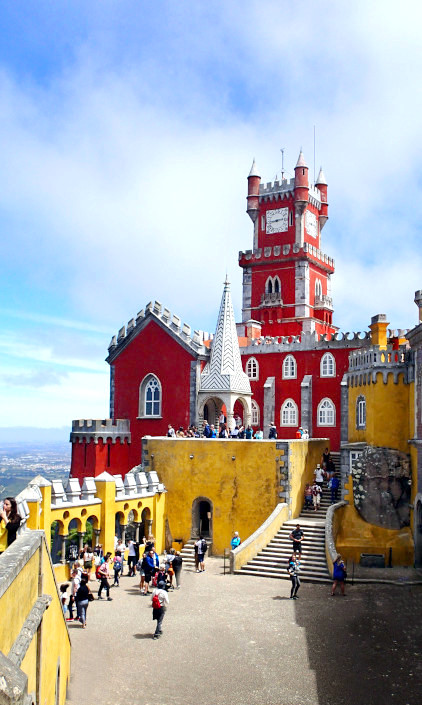
After spending some time on the terraces, it was time to join the queue for the internal tour of the palace. We grumbled a bit because it was snaking down just into the tunnel and we thought 20 minutes was a long wait. But by the time we got out of the Palace to explore the grounds a while later, that queue had exploded and snaked right down through and out of the castle, and beyond the lower bus stop. We estimated people had maybe 3 hours wait at that point to get into the castle. It was nice inside, but definitely now worth a wait of 3 hours. So be early or don’t bother if you are visiting during high season
Inside the palace, there were some rooms on display with original furnishings, decorations and displays. The older part that used to be the monastery had much smaller rooms grouped around what would have been a small cloister but is now a tiled courtyard with a fountain.
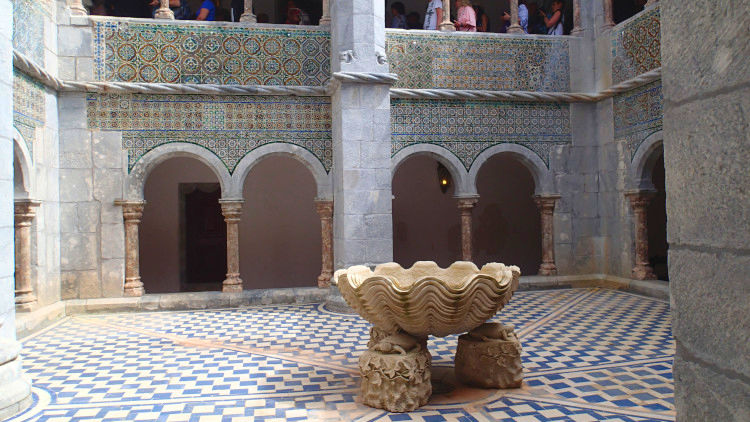
The queues aren’t limited to the outside – once you get inside be prepared to queue to see inside each room too. However, if you take your time and stay at the end of the queue of people or behind a group, you can get the place to yourself for a minute or two here and there, when it is suddenly very peaceful.

Each of the rooms has a brief description of how and when they were used, who the royal inhabitant used to be. This place would be amazing with an audio-guide to tell you so much more about the history of the palace, but then the tour would be so long they’d never get people through quick enough to clear the queues!
We very much enjoyed the stunning and skilful paint finishes inside the castle. The walls and ceilings were beautifully painted with trompe l’oeil that gave every surface a very opulent feeling and helped the small rooms feel larger. In this photo, it’s a flat wall but feels so much more 3d because of the clever painting.
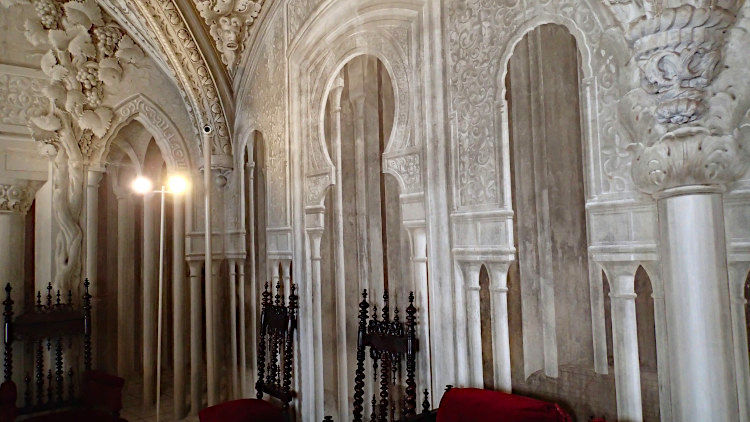
The newer part of the palace was more impressive, bigger rooms, higher ceilings, more decorative features. But these parts felt more like an impressive display for visitors and less personal. Not like the small, homely and comfortable rooms of the personal chambers in the older section.
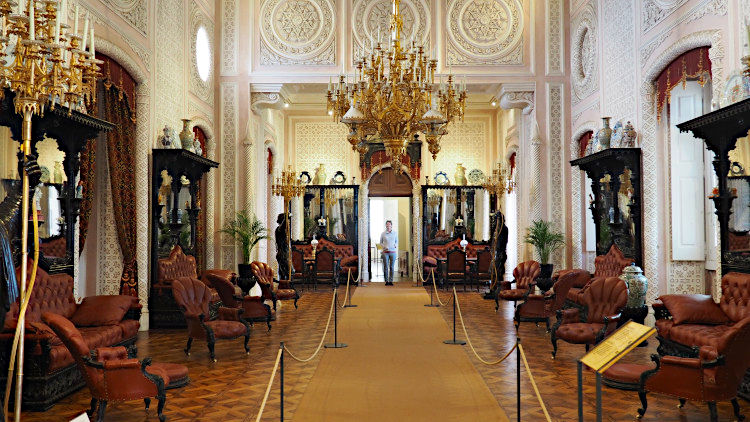
It was interesting to see that in Pena, and in the Sintra Palace later, the kitchens were probably almost the biggest room in the house. They would be if you added on the larders and utility areas. I suppose it reflects how much time, effort and how many staff it took to prepare foods before we had microwave meals! These palaces must have hosted some magnificent banquets in their day!
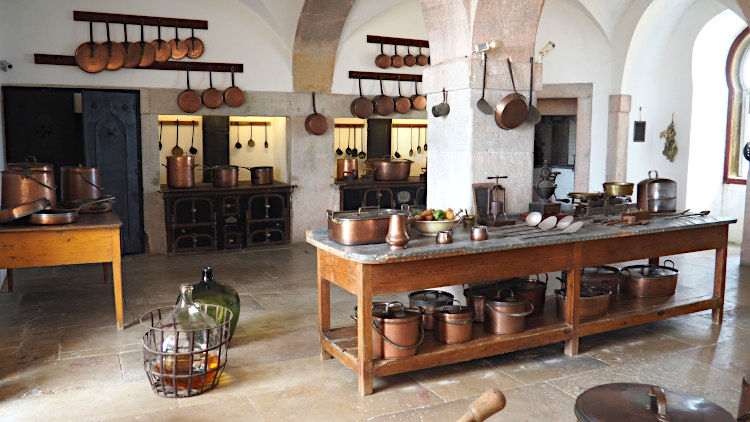
It was near impossible to get photos in the rooms without other people being there just because there were so many people and everyone was going slow, trying to do the same thing as us, and grab some great photos to remind them of their visit. So be patient, take your turn and just chill out. There are some spots where it’s nice to take a photo with the palace in the background, so ask someone to take one for you, and take a nice photo of them in return.
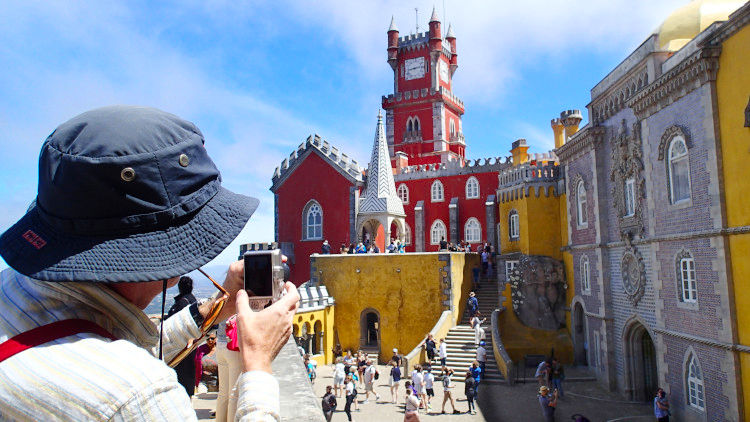
Time now to enjoy the palace exterior and the terraces, stop for a coffee, fill a water bottle and use the washrooms. Your visit isn’t over yet as there are expansive gardens to enjoy. Take one last photo of the castle facade, pass all of the people who are still queuing to get inside, and walk back down the slope into the lower gardens.
TIP: The gardens are large and although you can pick up a map at the entrance, the map isn’t easy to follow when there is such a maze of pathways. If you have Google Maps on your phone, you can actually use this to find your way around the gardens between the various highlights. Although the satellite image just shows the tree cover, the pathways are marked out for you to follow. We started our walk by climbing up to the High Cross.
From the high cross, the highest point on the hill, you get expansive 360 degree views including out to the magnificent coastline. It’s not too hard of a climb and the views are worth it. You can even get a view across to the Pena Palace but you’ll need a good zoom lens on your camera to really be able to capture the photo well. It’s very cramped up there on the top to be prepared to queue to climb up to the very peak to take your photo.
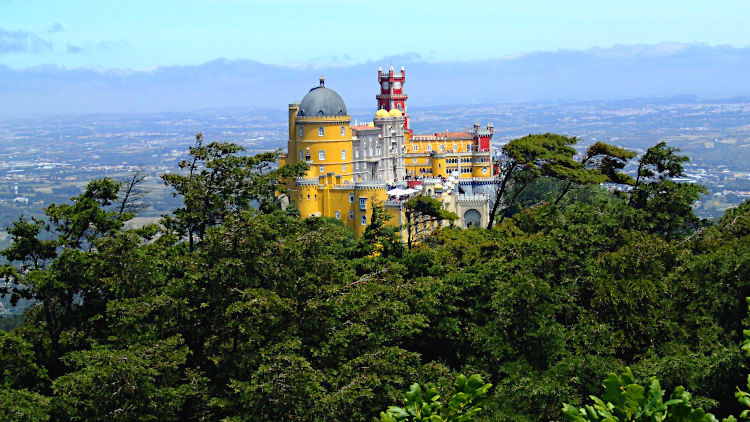
From there it’s a short stroll down to the Temple of Columns which is a nice place to sit and enjoy your picnic, if you brought one with you. Throughout the gardens you’ll find all sorts of tempting places to sit, but sometimes those places are not to be disturbed. Just look at the glorious moss growing on this bench – a really good image for how the park feels. It has an almost abandoned and overgrown nature about it while still managing to be tidy and well managed. It’s a real treat of natural landscaping, and the romantic Gothic style of gardening.
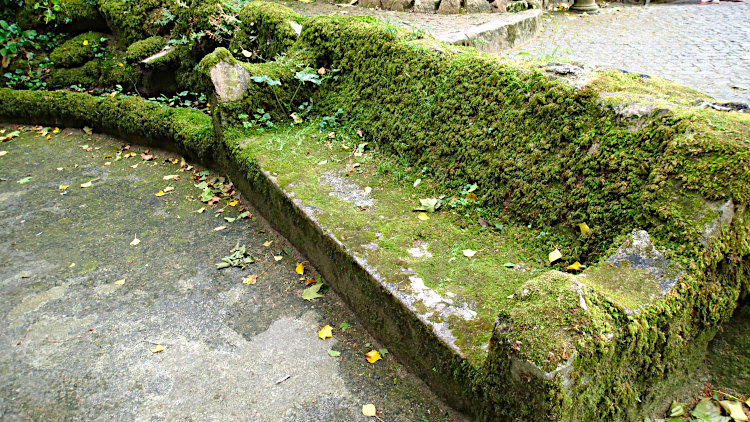
Then turn slightly back up hill to pass the Queens Octagonal Table and the Statue of the Warrior. Look up or you’ll miss it. It’s right up the very top of a huge pile of boulders. This medieval knight fits perfectly with the romantic feel of the gardens. Here it’s mossy, gloomy and mysterious but close to the top of the hill so light breaks through the tree canopy and shafts of sunlight illuminate the ferns below.
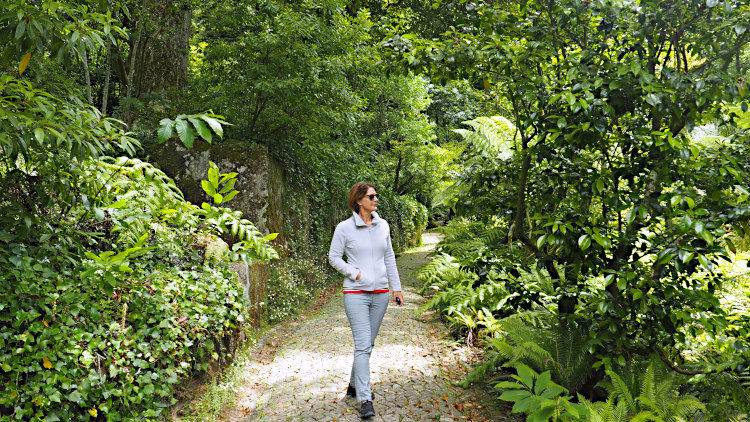
Everywhere you turn there are small rills of running water, or spouts dripping water into tiny clear pools next to a small stone bench. The water mine engineering behind the scenes in this park is something to behold. Every now and then you may come across a very narrow tunnel going deep into the rock with a metal gate across. Peer inside and you’ll see some of the reservoirs and channels that manage the water around the gardens and create the ever flowing pools and streams.
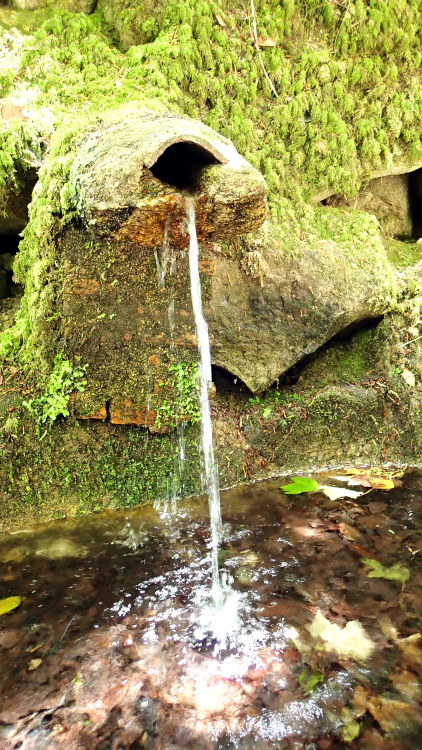
The planting is lush and green, very natural, with few flowering plants, other than in certain more formal areas such as the Garden of the Camellias, and in some areas around the lakes. I seriously don’t know how they would manage it otherwise, because it’s vast! We only covered a small area, following part of the red route on the map, but we could have been walking the gardens all day and still not would have seen everything.
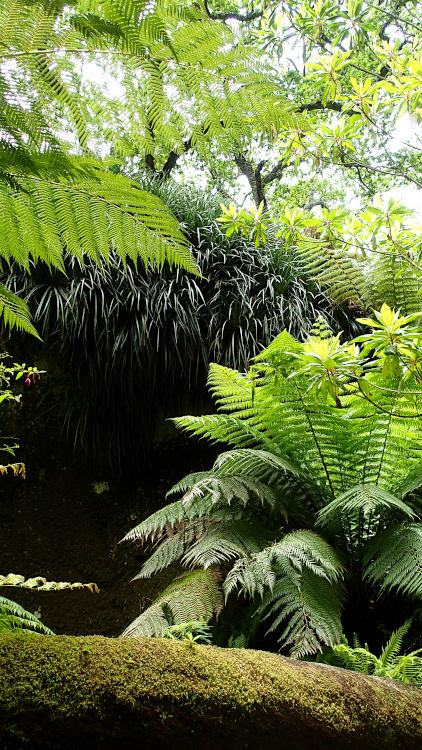
The Queen’s Fern Valley has the most perfect climate for growing tree ferns and the perfect combination of boulders, water, shade and planting here would rival any display at the Chelsea Flower Show. Follow the valley down and you’ll start to hear what’s coming next and be drawn to the water.
This small pond covered in waterlilies fills the air with the frog chorus and makes everyone smile. At first you can’t see any frogs, but keep looking and slowly you’ll start to spot one, then another, and another and you’ll be seeing them everywhere! There’s also a great tree just off to one side here with an enormous low branch that is great for photos.
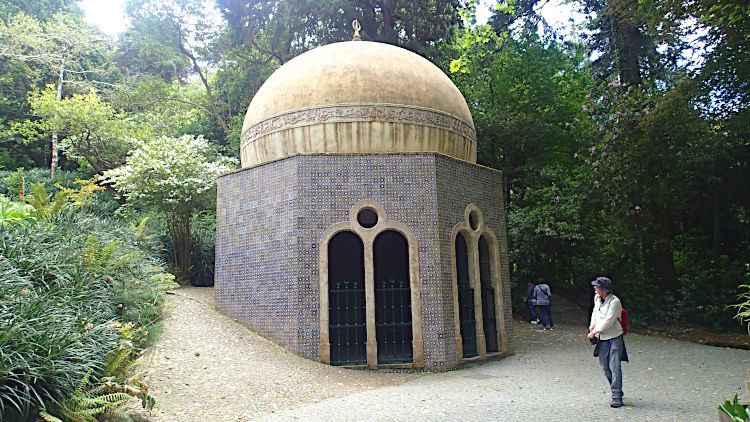
Just around the corner from the frog pond is the Fountain of the Small Birds Islamic style pavilion. Unless you plan to extend your visit over onto the far right of the park into the less discovered areas, you’ll know your visit is soon coming to an end.

You’ll finish the gardens down at the bottom by the lakes. There are some lovely features here including a selection of pretty houses on the lakes for the geese, ducks and swans to come out of the water and rest, sleep or nest. You still can see similar in public parks and gardens around Spain and Portugal today. Although not quite on the scale as these ones!
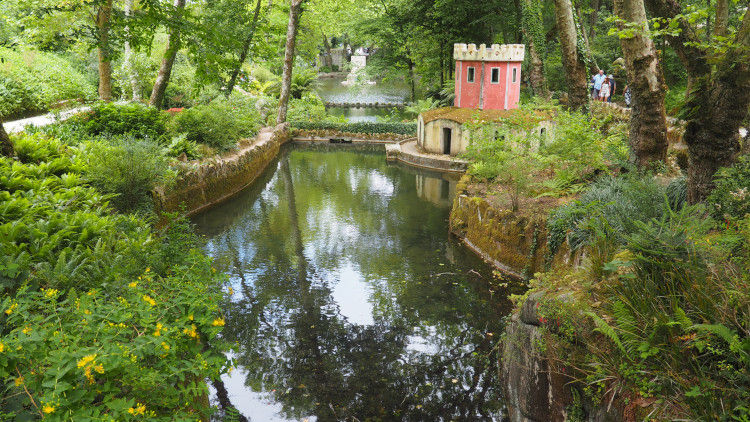
Just look at that one in the centre of the lake! Like a romantic medieval castle for ducks.
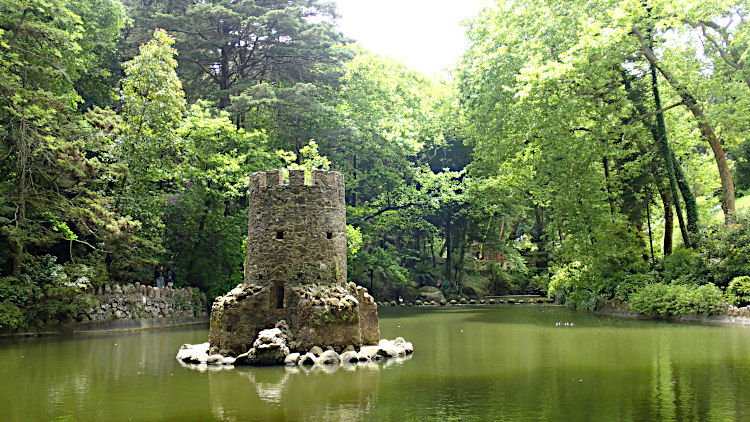
You can now reluctantly exit the Pena Park and Palace through the lower gate at the Gate Keepers Cottage.
Moorish Castle
It’s just a short walk back up the road, about 350m from the lakes up to the Moorish Castle. Buy your tickets at the booth if you don’t already have them, but if you do you can avoid the wait and entry is on the left-hand side, through a small arch and down a winding path. If the Palace has left you feeling a little overwhelmed and overcrowded then a trip to the exposed Moorish Castle will refresh you.
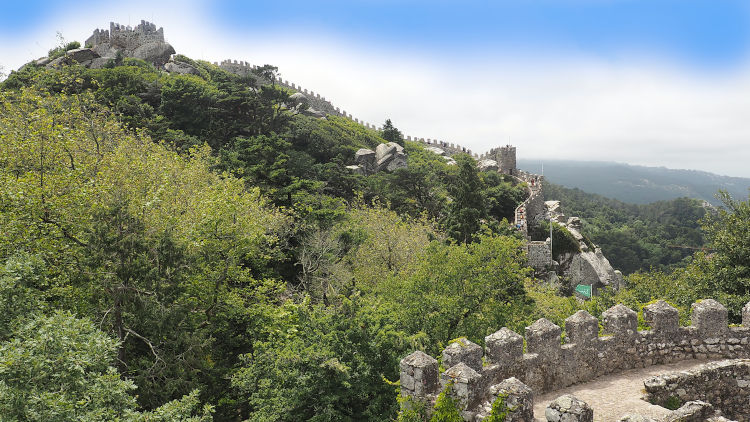
The Castle of the Moors, founded by the Muslims from the 9th century, dates back to the period of Islamic rule and to the conquests of D. Afonso Henriques, the first king of Portugal. The castle fortress remains in excellent condition as no battle was ever fought here. Its function would not be the defence of the village of Sintra, but rather as an outpost keeping watch over the roads to Lisbon and its surroundings.
After the conquest of Lisbon (1147) by forces loyal to Afonso Henriques, the castle surrendered voluntarily to Christian forces.
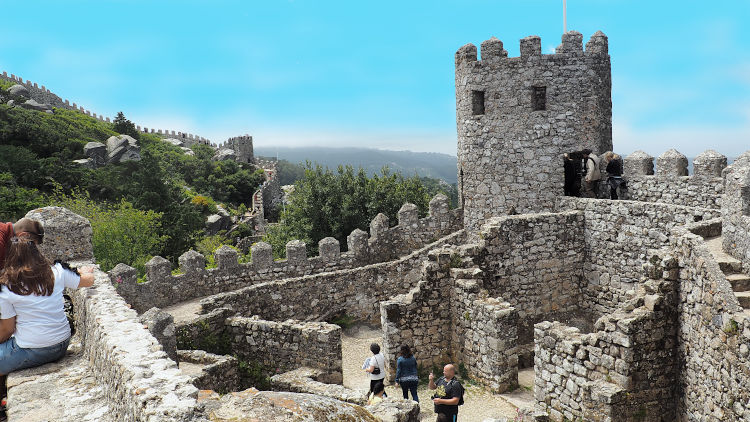
The castle walls are built following the natural contours of the top of the hill, and incorporating the massive boulders that make up the landscape. It’s rather magical to stand on one end and look along the 450m length of the walls and the towers – almost like a mini Great Wall of China!
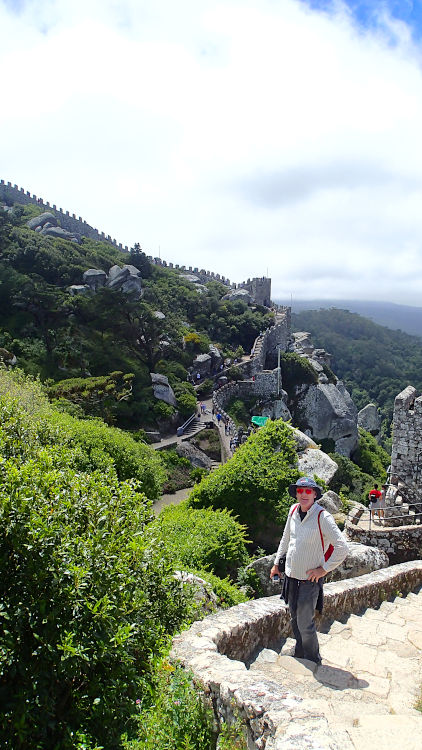
We were there on a very windy day with a lot of low cloud and it felt really exposed and windswept, but also rather refreshing after the confines and the richness of the previous palace and gardens. It is nowhere near as crowded and there was no queue to get in, just a pleasant stroll through the woods.
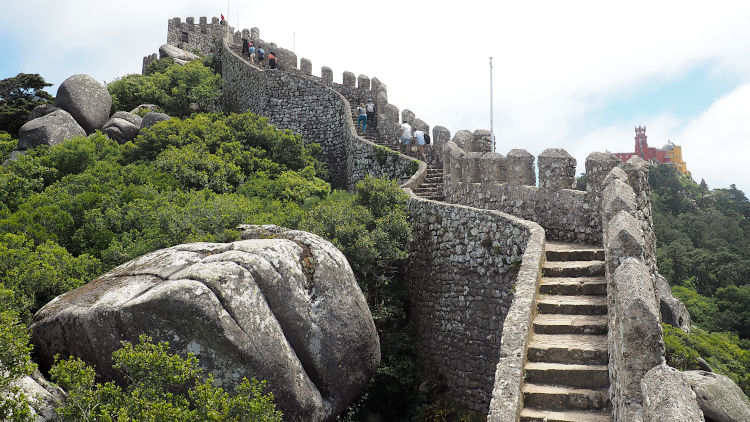
All the fun of the castle comes from climbing the towers and walking the length of the walls. But beware, the walk along the walls is fairly high and the ledge fairly narrow, and there isn’t any guard rail on the inside edge. So if you are afraid of heights you might find it a bit uncomfortable. Certainly by the time you have climbed right to the top you will definitely be feeling out of sorts if you don’t like heights. Watching people perch right on the edge to get the best selfies with nothing underneath them but air can be a bit unnerving!
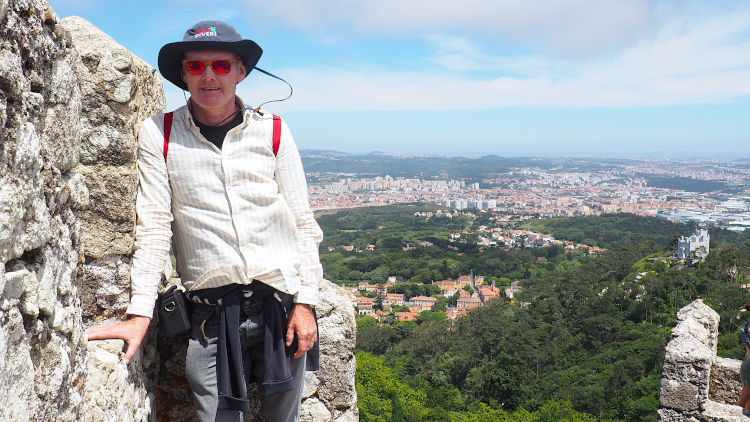
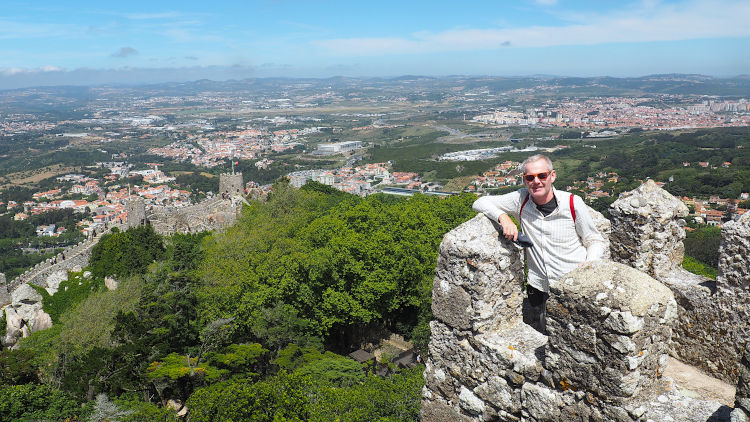
At the end of your visit, return to the courtyard and then look for the steps leading underground. You’ll find a huge cistern under the courtyard measuring 18m long, by 6m wide by 6m high. It’s beautifully cool in here and still holds water today. We wondered how they made it waterproof in those early times. It was clearly good work for it to still be functioning now.
The ticket for the castle gets you inside the inner ring of walls and allows you to walk the narrow ledge along the walls and climb the towers. But if you are on a budget, there is still a lot to see outside the ticket area and you can follow along the outer wall, see some of the excavations of the original houses and the later graves. Most interesting are the large smooth holes cut down into the rock to use as food silos for storage. The walks along the footpaths through this area are worth doing, even if you don’t visit the castle itself. It’s the perfect way to walk back down into town.
After the visit to the castle, follow the path through the woods marked historic center. You’ll take a pleasant 20 minute walk back down into town – no bus needed. The Sintra Palace is easy to find, just look for the two conical white towers on the skyline.
National Palace of Sintra

The Sintra Palace dominates the square in the historic town centre. You can look down on it from high up on the hill while visiting other attractions and it shines like a beacon with it’s bright white finish.
Also known as the Royal Palace or Palácio da Vila, the Sintra National Palace stands in Praça da República, the historical centre of Sintra, with two monumental conical chimneys coming from the kitchen to form its trademark image. With an Arab foundation, it became, from the twelfth century and for about eight centuries, the residence of the Portuguese royal family, being the only surviving medieval royal palace.
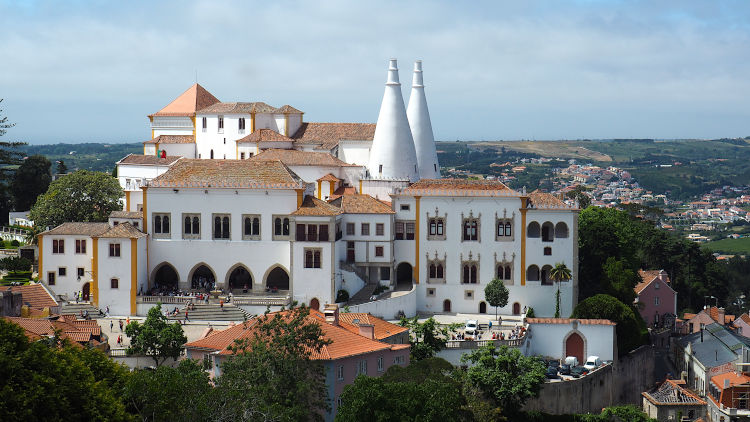
By the time we arrived, the crowds were all back on their coaches so the place was quiet with no queues. We did happen to get behind a small tour group but otherwise there were only a few people still here. It made for a much nicer slow down to end the day. There are no grounds or gardens with this visit, it’s all inside so it’s also suitable for bad weather days.
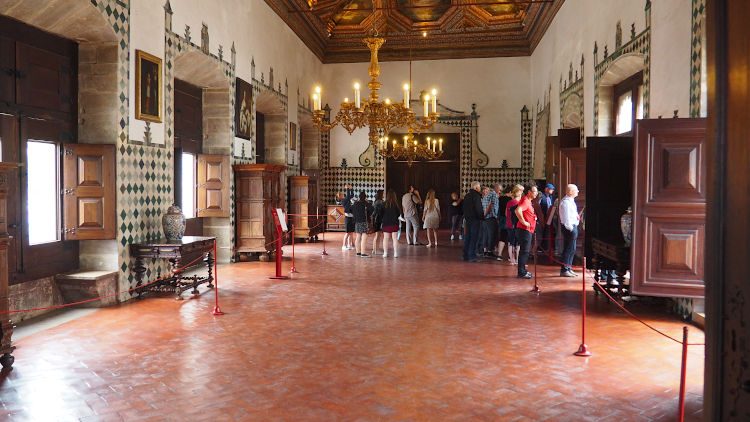
This palace is well known for it’s amazing painted ceilings. The room above is the Swan Room, the largest reception room in the palace which still features the early tiled wall decoration. First mention of the Swan ceiling comes from 1570. As you can see, furnishings here are sparse but there are some nice paintings. There isn’t any information about the history or any of the rooms other than bare notes about some of the furniture or art, but you are given a map with info to read as you tour.
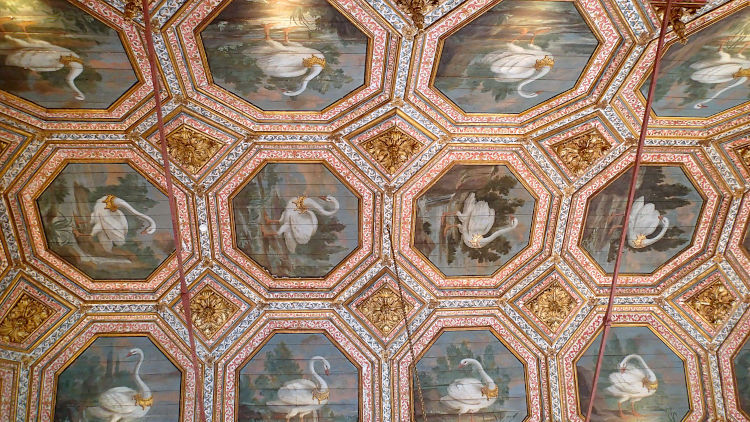
I was particularly taken by these large ceramic tureens. It looks as though they would have soups or stews served in them. There were similar ones on another table featuring fowl such as chicken, turkey and what may have been a pheasant.
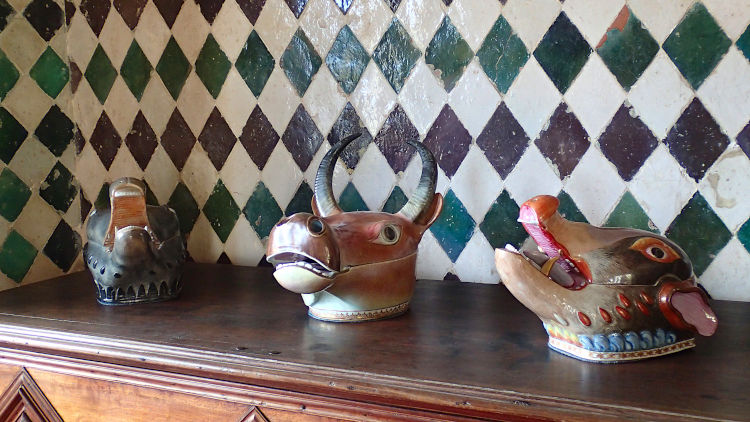
The second impressive ceiling we find is the Magpie Room. Who knows why the occupants were interested in magpies, but the ceiling dates to the 15th century and the birds hold the banner of King Joao 1st in their beaks with a rose in their claws to represent his wife Queen Phillipa. This room was used to receive dignitaries and foreign ambassadors.
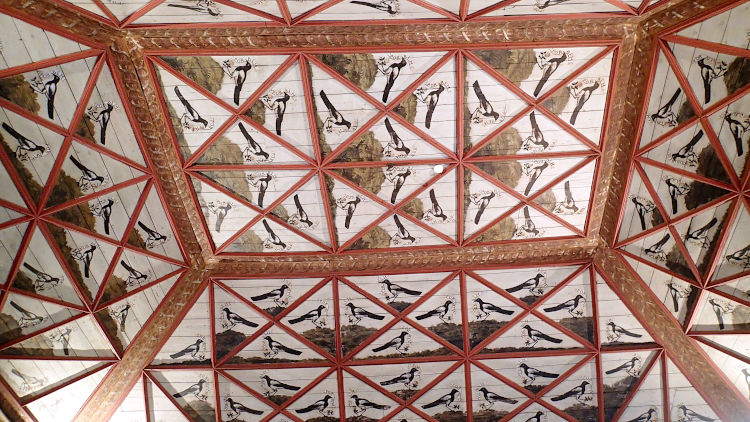
As usual, Deby found interest in the doors and windows. This door in the corner of the magpie room shows off some of the impressive early tile work that decorates most rooms of this palace.
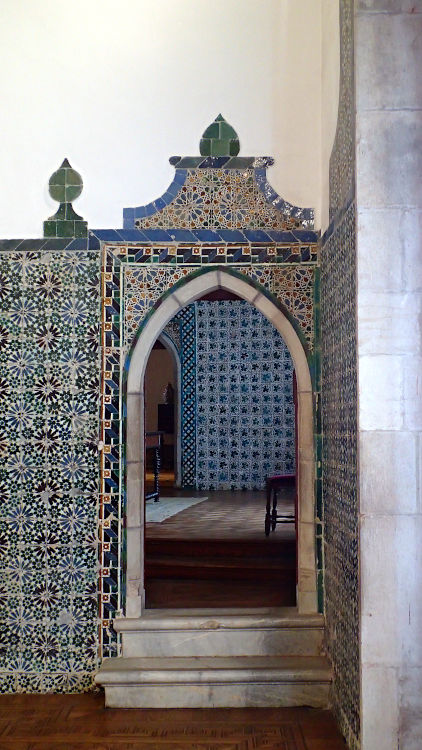
We follow through into the King’s bedroom. Again there is some very lovely tile work, this time embossed leaves. The rooms seem quite modest to us these days, but imagine how enormous and highly decorated they must have seemed years ago. This room features one of the most important items from the palace collection; a large gilt copper celestial globe of the heavens dated 1575. We could not get close enough to see the etched details but I would love to see how the heavens were represented then. This is one of the most valuable 16th-century globes still in existence today.
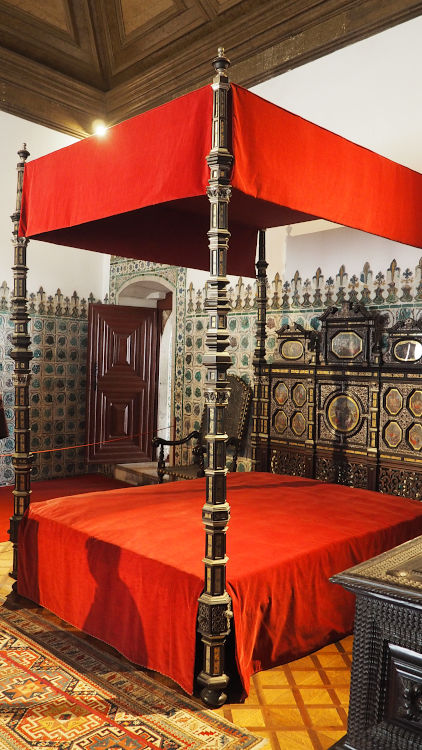
Another example of a beautiful painted ceiling comes in the Gallery Room. The domed ceiling from the turn of the 17th century features seascapes and vessels flying flags of the Ottomans, Dutch and Portuguese. The gallery features decorative tiles along the bottom of the wall and huge paintings of royalty look down on us poor minions.
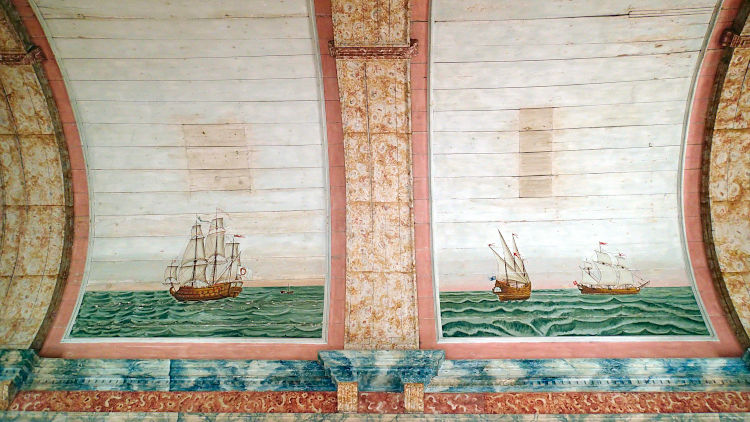
The highlight of the palace must be the Blazons Hall or Heraldry Room. It’s one of those rooms where you walk in through the door and literally stop and gasp. It’s a wow moment. The decoration is at once overwhelming and makes you step inside to see more. The most important heraldry room in Europe, it’s an allegory for King Manuel 1st’s centralised power.The 18th century tiles panels depict hunting scenes, country life and general excess.
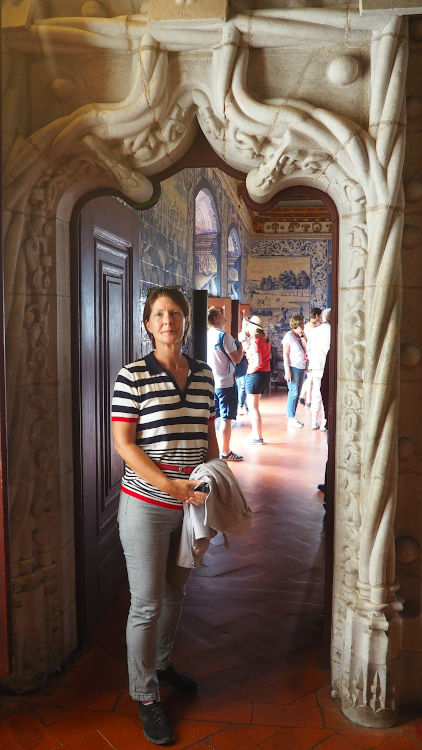
The ceiling of the Blazons Hall is an important work of heraldic records of the first quarter of the 16th century that is still a reference point for scholars today. It seeks to identify and record all existing blazons at a time when the use o oats of arms was highly arbitrary. I can’t speak to it’s historic importance, but it certainly is a feast to the eyes.
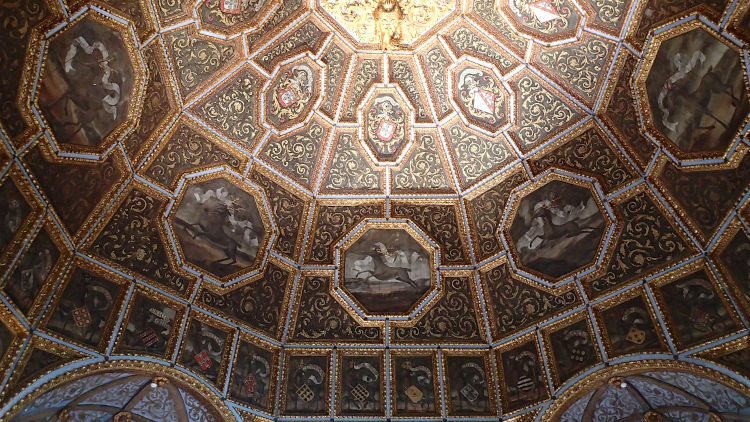
An example of the large tiled wall decoration can be seen below. These panels must measure somewhere in the region of 13 feet across. The lower panels along the wall feature gargoyles and fantasy creatures.
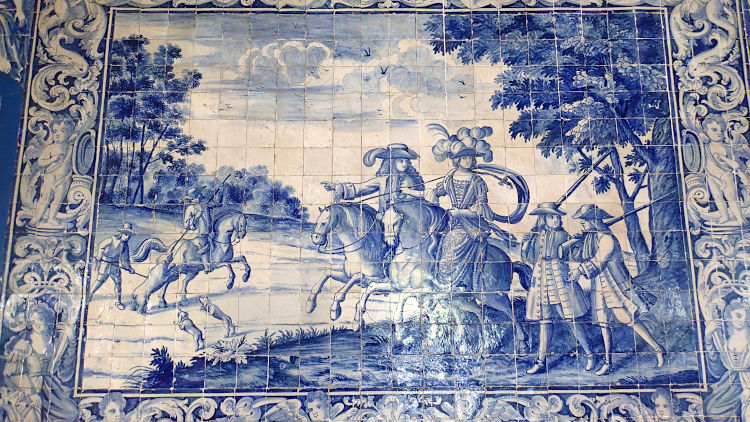
At the moment the Palatine Chapel is closed because it needs restoration. Several parts of the ceiling are sadly coming away. But there is a viewing gallery at the back to admire the woodwork. Founded in the early 14th century, the chapel has a carved wooden ceiling with latticework that firn radial and star compositions. This ‘Mudejar’ woodwork and tiled floor are some of the oldest examples in Portugal. The painted wall frescoes date from the 15th century show a motif of doves carrying branches in their beaks.
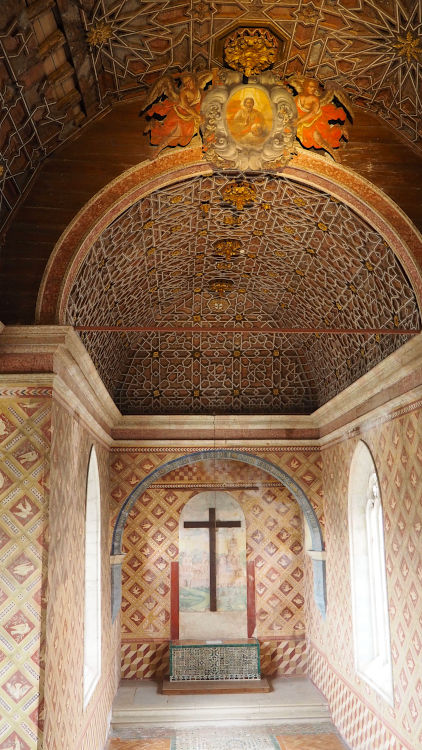
The massive kitchen signals the end of our tour of the inside of the palace. Designed to cater to hunting banquets, the kitchen has two 33m high chimneys to allow the heat and smoke from cooking to escape. There are a number of large cooking fireplaces and a rack with enormous spits for roasting the meat. All with an easy-clean white tiled finish.
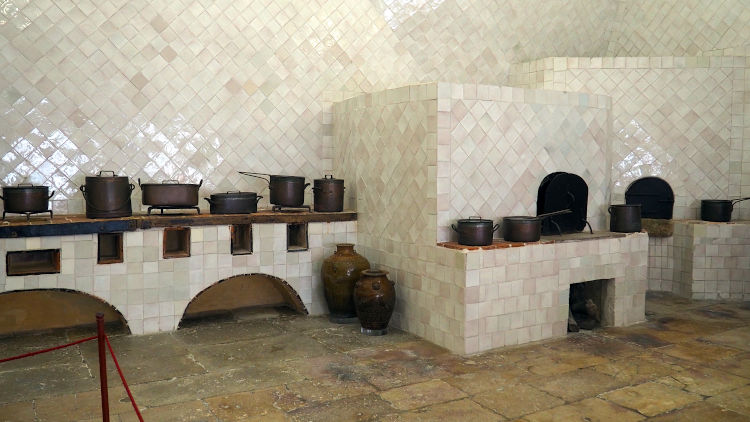
We come out into the small courtyard of the Central Patio, the focus of the surrounding rooms. Here you can find the ‘water grotto’ a large tiled alcove with stucco decoration behind pillared arches. Fully decorated in blue and white glazed tiles, it you look carefully you can see the lines of holes in the tiles where jets of water would have arched through the air
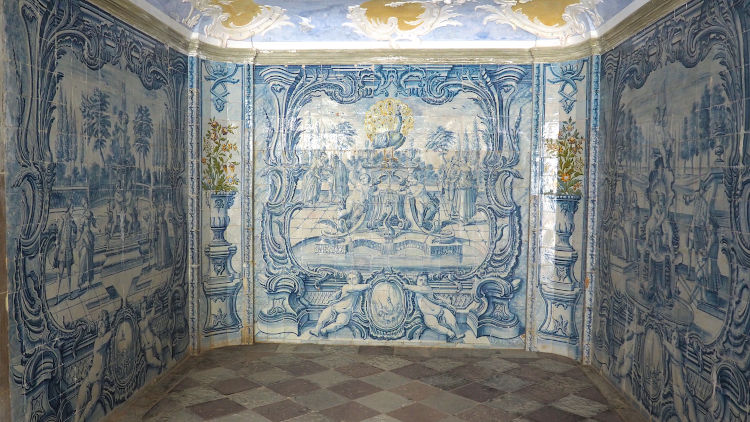
And that concludes our visit to the Sintra Palace and our day of sightseeing. Our feet are a bit sore, our necks are a bit sore from staring at ceilings, our camera batteries are spent. Time to pick a coffee shop or restaurant, put our feet up and reflect on the day. But it’s not over yet, Sintra still has so much more for us to see! Set the alarm to get up early tomorrow.
Day 2 – Quinta da Regaleira and Palace of Monserrate
If day 1 was a bit overwhelming and the crowds just too much, don’t skip day 2 thinking it will be the same. The coach parties and tour groups do the sites you visited on Day 1 but there are other amazing places to see where the tour groups don’t visit. Today will be much quieter and you may love it more than yesterday – we did.
The weather was also much better for us on this second day. The wind had died down and the sky was blue.
Our route to the two palaces today follows that of the 435 bus, but we started from our camping by getting an Uber direct to our first stop, the breath-taking Quinta De Regaleira and the famous well.
Quinta da Regaleira
Check out the slideshow below for some of our favorite images of Quinta da Regaleira
It’s every visitor’s dream of visiting the famous Initiation Well and having the place all to themselves – but that’s really not going to happen in Sintra unless you get there first! We decided we’d like to give it a try, after the very busy day we had yesterday, so we were at the gates by 9:00am ready for the 9:30 opening.
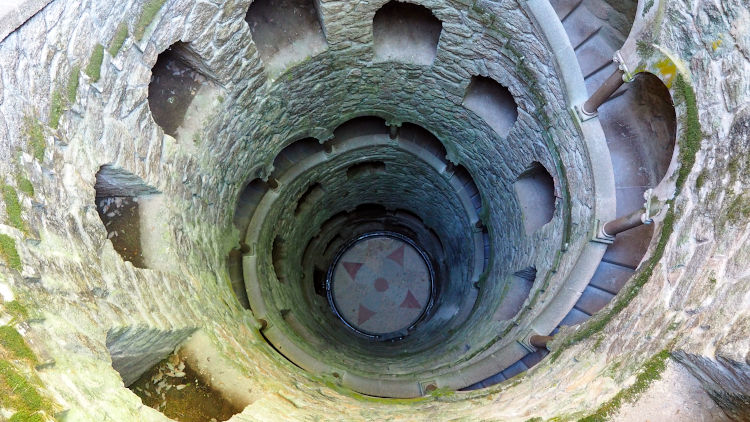
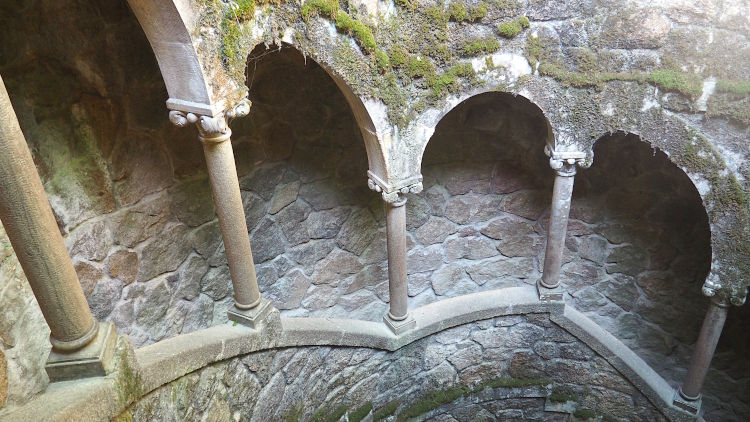
We weren’t first, there were only two gals there already and they told us about how they came yesterday and it was SO crowded at the well with people pushing and shoving to try to take photos, that it felt really claustrophobic and unpleasant. So they are here first in the queue to get the place to themselves today. They were such interesting people! On a 2-week vacation visiting abandoned houses to take photos. Here are their Instagram accounts – oh yeah, these gals know how to take a good photo! Scarlett and Dafne.
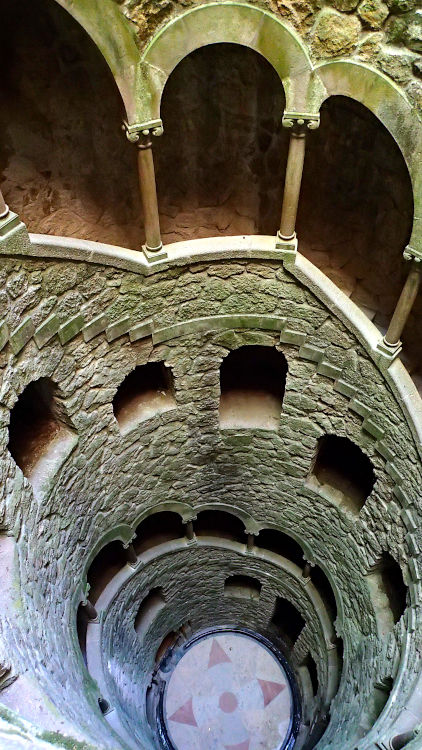
When the gates opened they were off and running to get their photos of the well. We were close behind – but not running, old age you know… we gave them their space and they got the photos they wanted, then it was our turn and much to our surprise, no one else turned up for quite a while, so we were able to enjoy the peace and quiet and the amazing atmosphere of the well just on our own.
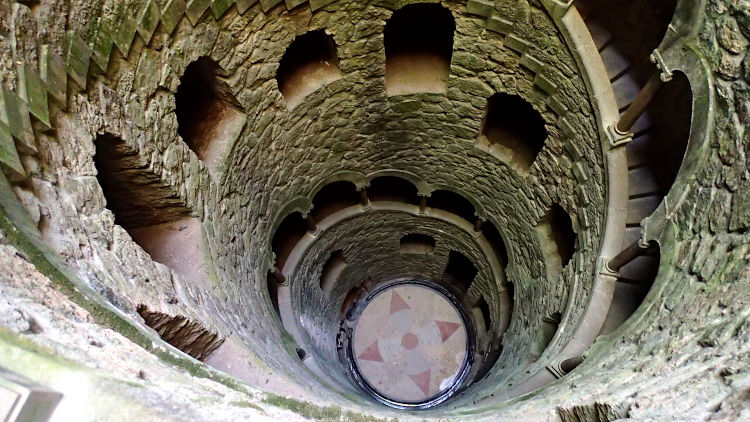
Sadly we can’t take a good photo to save our lives, and really didn’t have the wide angle lens needed to get the best shots but we were still happy to have got the chance to explore this amazing architectural and historical feature just the two of us. It’s an amazing thing to see and reminds us somewhat of the Tower of Pisa, but turned inside out and upside down.
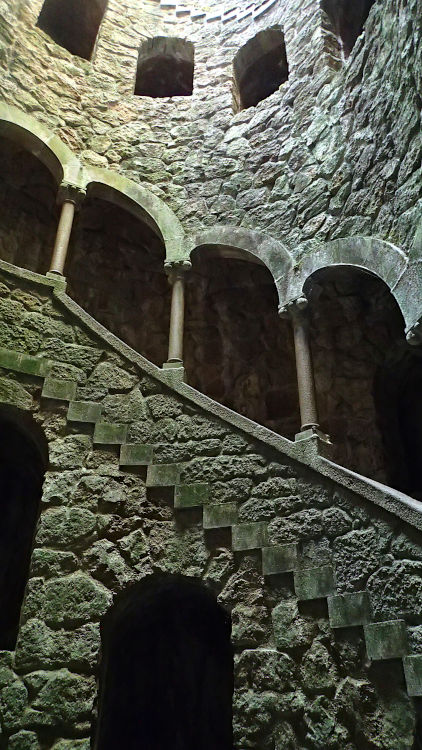
The Initiation Well or ‘Inverted Tower’ consists of winding stair architecture carrying symbolic meaning or death and rebirth. The well contains 9 platforms said to be “reminiscent of the Divine Comedy by Dante and the nine circles of Hell, the nine sections of Purgatory and the nine skies which constitute Paradise.” At the bottom of the well is a compass over a Knights Templar cross. There are niches in the walls at each level for statues, although none remain now. Very little is known about the well and what exactly went on there but it is thought to have been the site of various rituals and initiations. How fun!
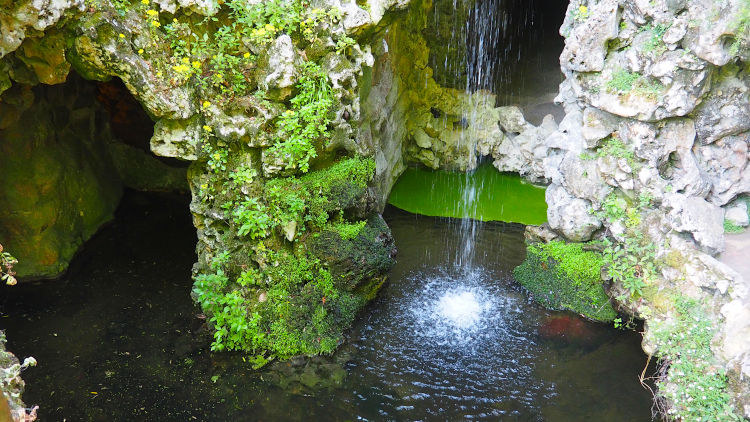
Once you climb down the well to the bottom, there is a maze of underground tunnels that lead you to the back of a waterfall and pool. Take the stepping stones across to get some great views and you’ll come out back into the gardens. The gardens and the fun grottos and structures are definitely the best part of this site for us. There is something to delight in at every turn.
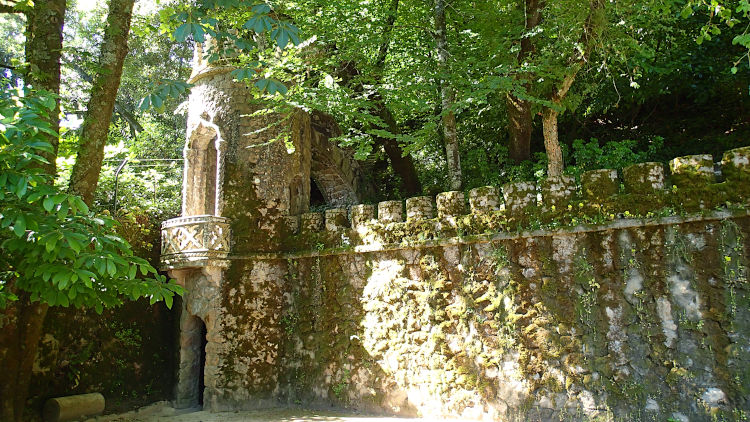
From the well, we went to the small fairytale tower in the corner of the tennis court. We climbed up through and followed the steep path to the Aquarium Grotto and then climbed all the way up to the top of the garden till we got to the wall. From here you can follow the map and the paths down all the way through the gardens to make sure you don’t miss any of the fascinating grottoes, pools and buildings.
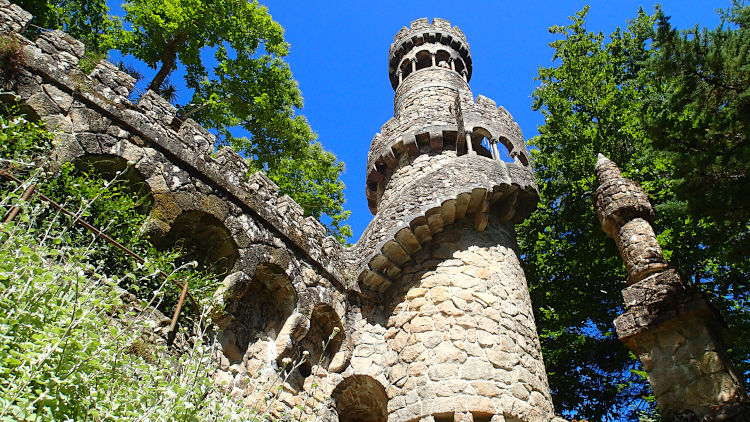

If you have a sloping garden of any size, this is the place to come to for inspiration on how to not only deal with it but really put that slope to your advantage. The landscaping is exceptional, with the levels seamlessly blending into a romantic journey with fairytale places to discover. Everywhere it feels cool and secluded, with the constant sound of dripping or running water, or the serenity of a pool.
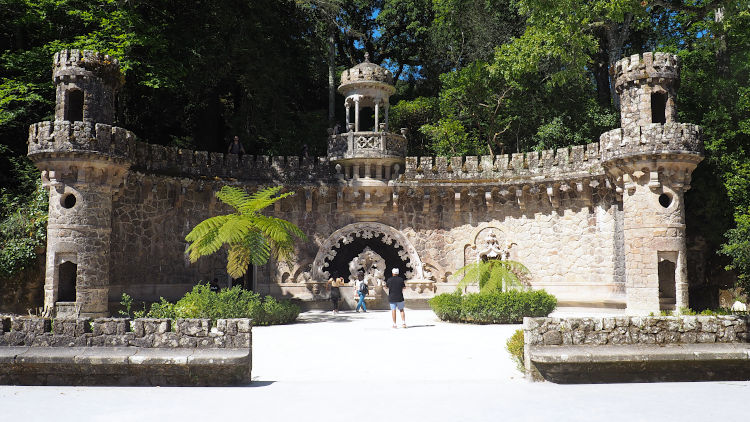
One of the hidden gems is the Labyrinth Grotto, hidden in behind the large lake near the bottom of the garden. There is the first ring of passages which opens onto the back of the lake affording views over the water – but beware, although it looks like a bright green mossy surface you can walk on, that’s actually the surface of the lake! Don’t step in!
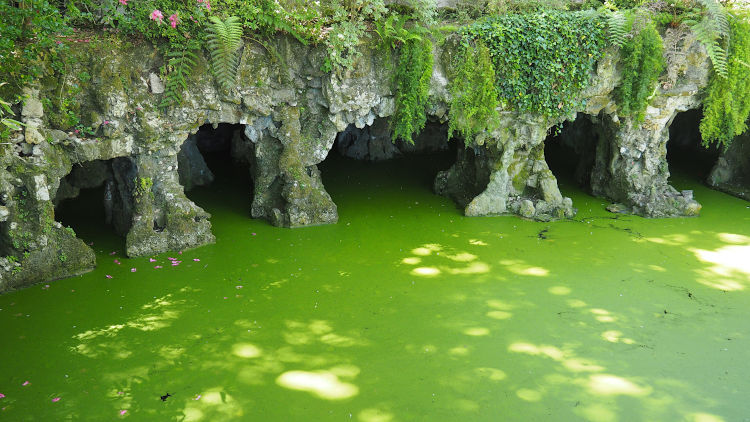
You can follow this first set of passageways with light from the outside, but if you look carefully you’ll see another passageway branching off into a dark corridor. Make sure you’ve got plenty of battery on your phone and turn on the torch – you’ll be rewarded by a long set of tunnels you can explore which are in complete darkness. And we mean complete. Turn off the torch and you won’t be able to see anything – not even if you wave your hand in front of your face. It’s so dark you can’t tell your eyes are open. An amazing experience, but not for those who suffer from claustrophobia.
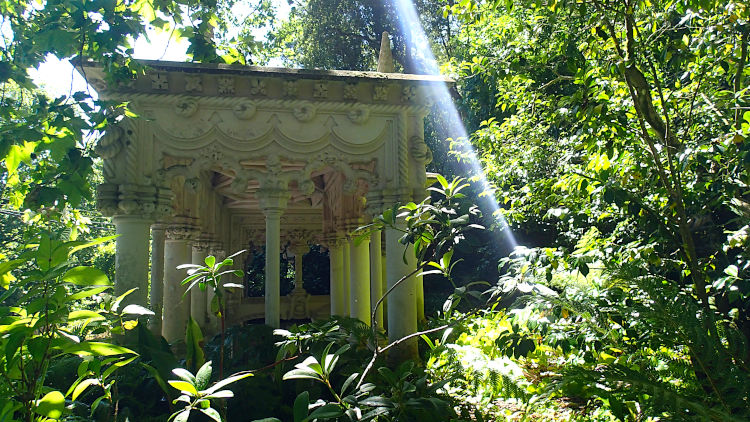
As you get to the lower part of the gardens and the house comes into view, do visit the small loggia affording alternative pedestrian access to the street. It’s superbly decorated with carvings and tiles, although could benefit from a little clean.
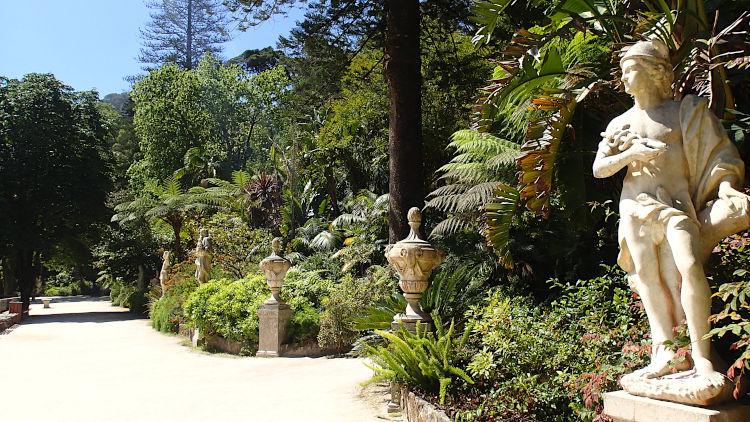
The Promenade of Statues leads you from the loggia towards the house and chapel. The chapel has interesting nautical stone decoration and is exquisitely decorated inside with mosaic floors and walls. You aren’t able to go inside but can view from the door.
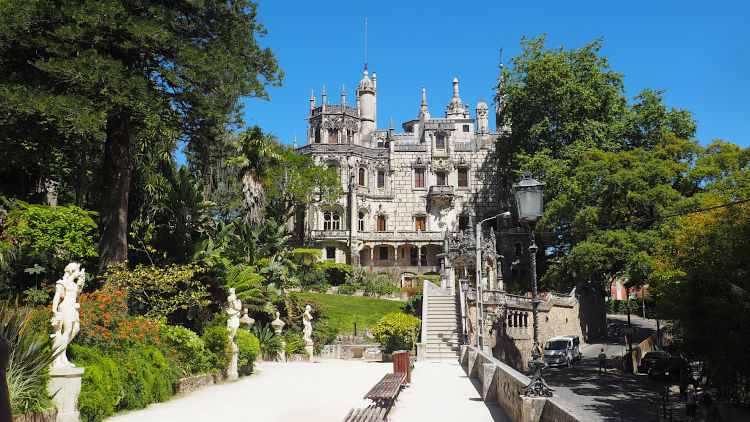
Now time to visit the grand house. We found it to be quite a mixture of styles. On the outside again there is a strong nautical feel to the stonework, with elegant stone rope.
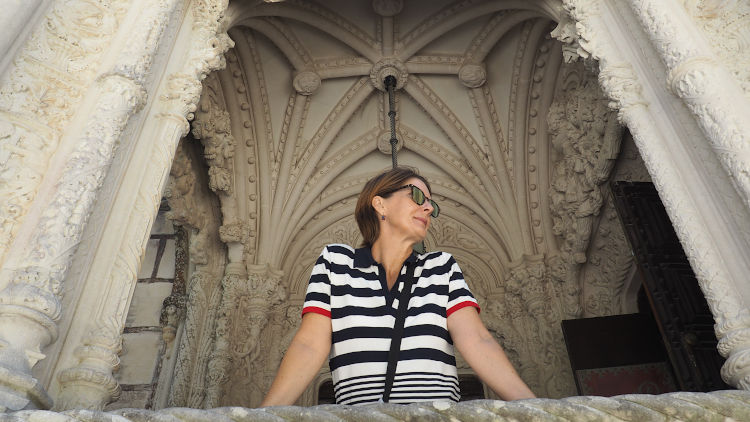
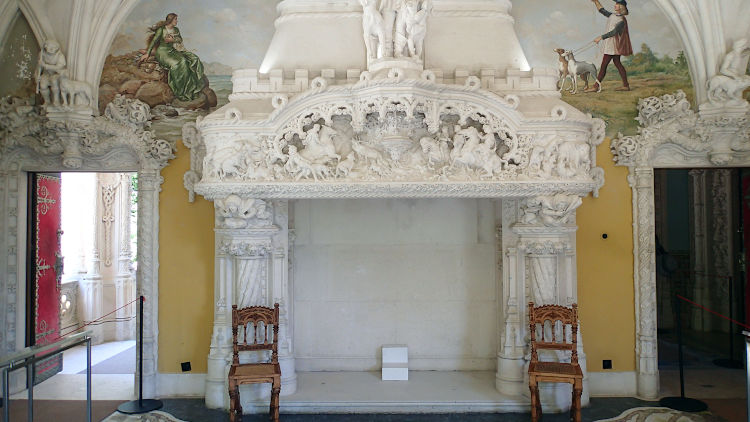
The first room inside is our favorite. Featuring a huge fireplace with the most delicate paintings either side on the wall. The lady in the green dress holding shells and starfish is exquisite.
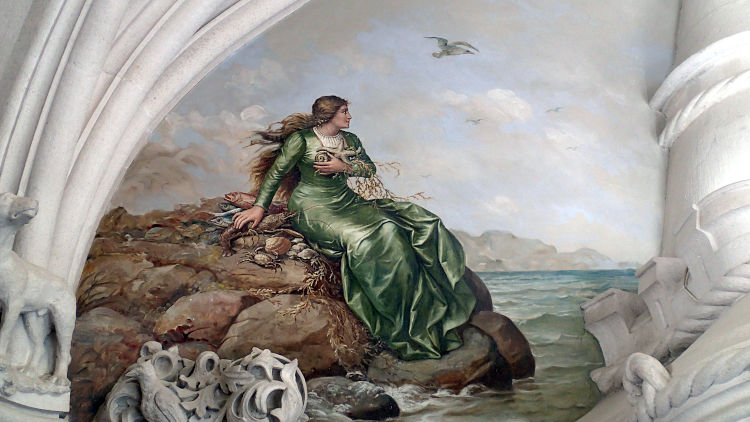
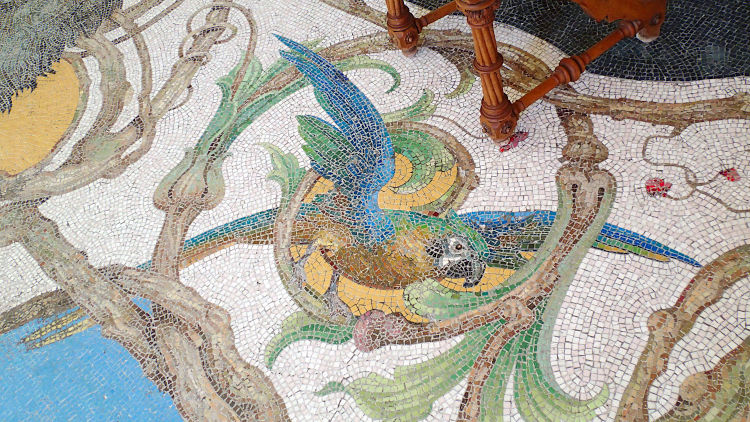
The floor has a wonderful tropical mosaic and the whole feel is open and airy. Contrast this to the rest of the house however and we didn’t like the style as much as this first room. The woodwork was dark and the carving heavy, with overly twee romantic wall murals which felt old fashioned rather than classic and timeless.
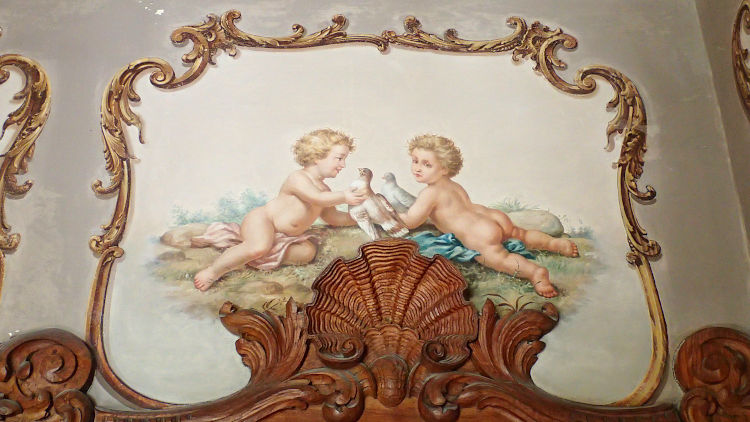
When you finish your tour of the house, enjoy the views over the garden from the terrace and then exit by the lower gate. You’ll come outside right onto the road next to the bus stop.
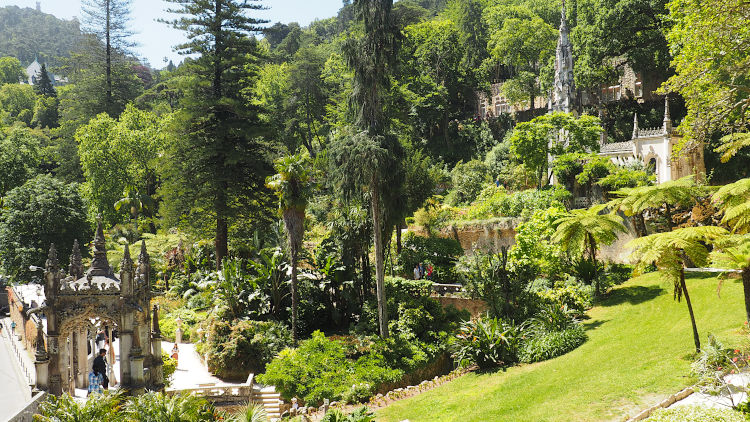
We found it easiest to take the 435 bus from here to our next stop. The price was €2.35 each person to get to Monserrate. If you wanted, you could stop off in between to visit Seteais Palace which is now a luxury hotel, and extend your day to 3 visits.
Park and Palace of Monserrate – the most beautiful house in the world?
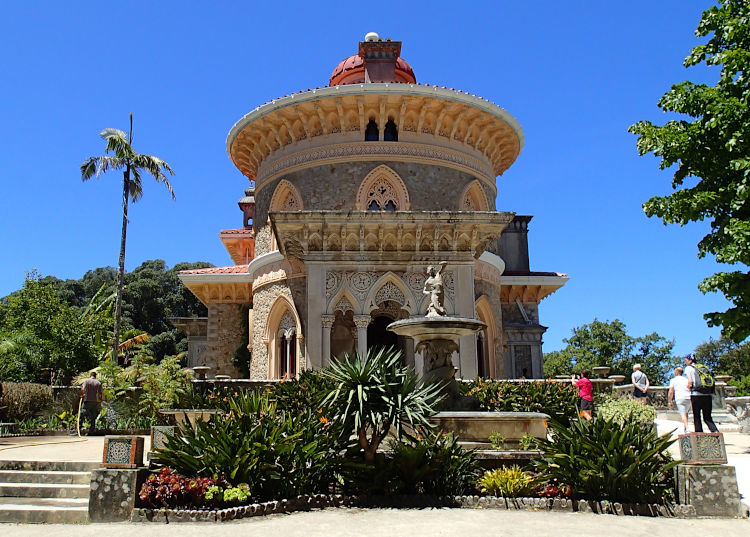
Originally built in 1789, in 1863 the Palace of Monserrate was fully refurbished into the summer residence for the Cook family. Francis Cook was an English textile millionaire and owner of one of the finest private art collections in Britain. The present romantic gardens and house were created under his supervision, in the eclectic spirit of the 19th century.
Not very far from the historic centre of Sintra is one of the most beautiful architectural and landscape Romantic creations in Portugal: the Park and Palace of Monserrate, unique representatives of 19th century eclecticism. The Palace combines gothic and Indian influences as well as Moorish suggestions together with exotic and plant motifs which are harmoniously extended to the exterior. The gardens have received species from all corners of the world, which were planted according to their geographical origin.
We start at Beckford’s Waterfall, where the water falls from high, and bounces off the rocks before falling to the lily pond below. There are some large stones here right by the lake where it’s nice to sit and eat your packed lunch. Cross the large stepping stones and continue on the path and the ruined chapel will come into view.
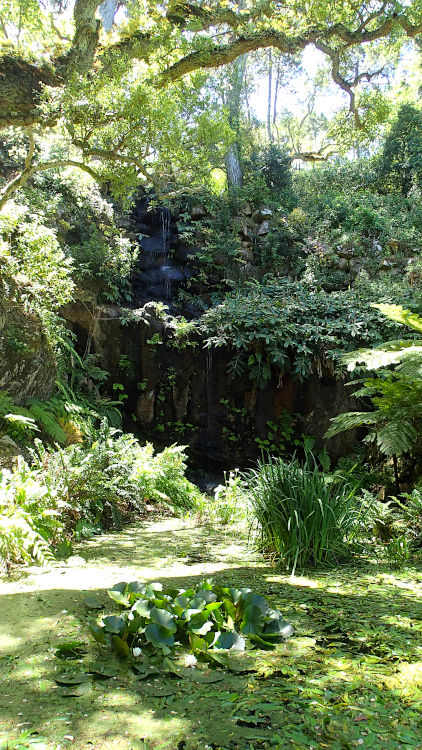
You enter the Monserrate estate at the very top. There is a steep valley running through the middle and the house is on the highest part of the estate, on the opposite side of the valley. So your path to the house is best taken through the gardens with the visit to the house (the best part) at the end of your tour.
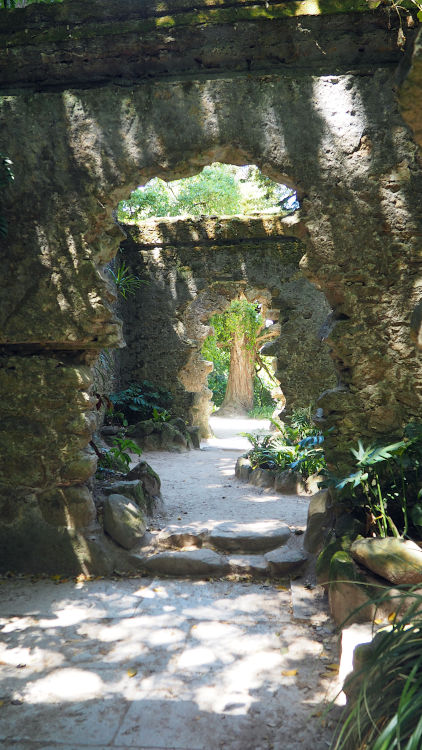
This is a false ruin, built as a ruin by Francis Cook, as a Byronic focal point for the garden. (Byron did once feature Monserrate in one of his poems.) Set above the ornamental lakes, it’s deliberately overgrown with cleverly designed vistas through to the lakes and woods beyond. The perfect place for some romantic wedding photos.
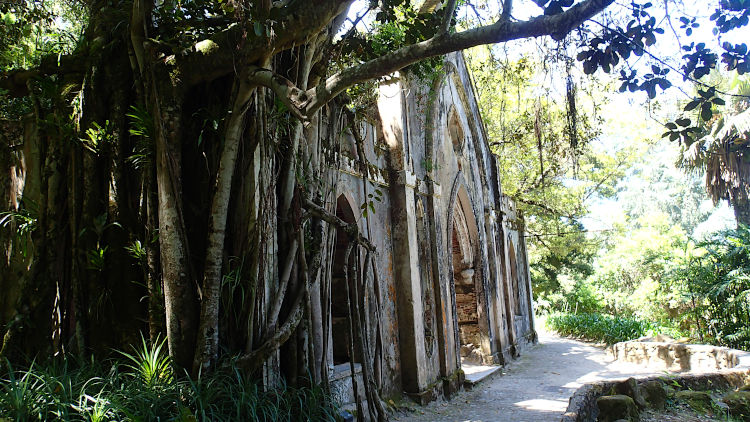
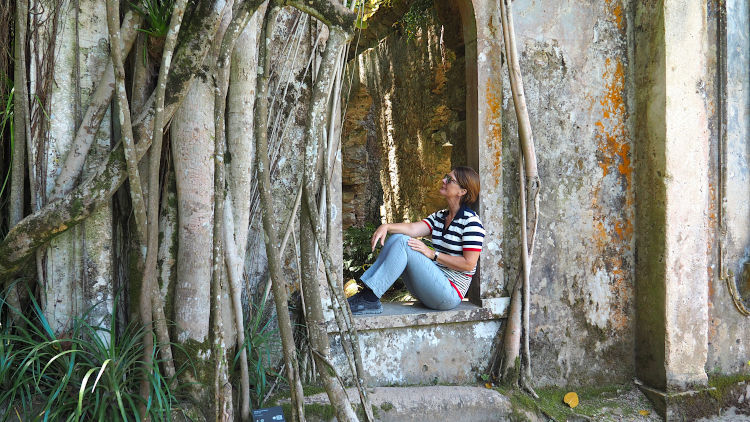
This wooded slope of the garden is the more natural and informal side and the furthest away from the house. Looking in this direction, it’s so cleverly integrated into the wider landscape that it is impossible to tell where the gardens end and the wider landscape of the hill continues. From the house, it would make it appear that the estate went on much further than it actually does – which is already a long way!
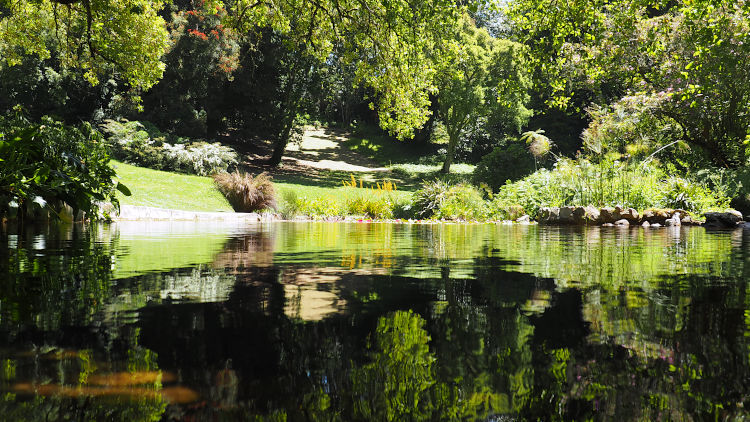
We now move into the more formal laid out parts of the garden. There are pretty ornamental lakes with water lilies set in open parkland. It feels very British in this part of the garden and Francis Cook and his family must have felt very much at home here by the lake.
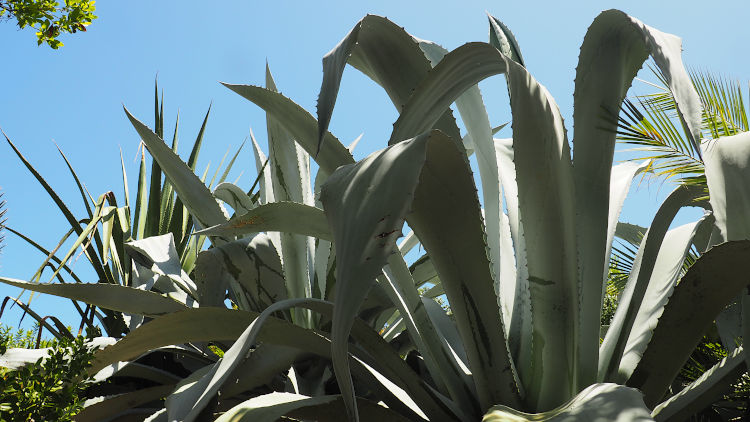
From here we continue to the sunny southern slopes of the garden into the Mexican Garden with agaves and cactus. Apparently, a Mexican garden was de rigueur at the time and they had the perfect place for it. The entire garden is a captivating mix of both tropical and temperate plants growing alongside each other in combinations you don’t usually see, thanks for the unique climate on the Sintra hill.
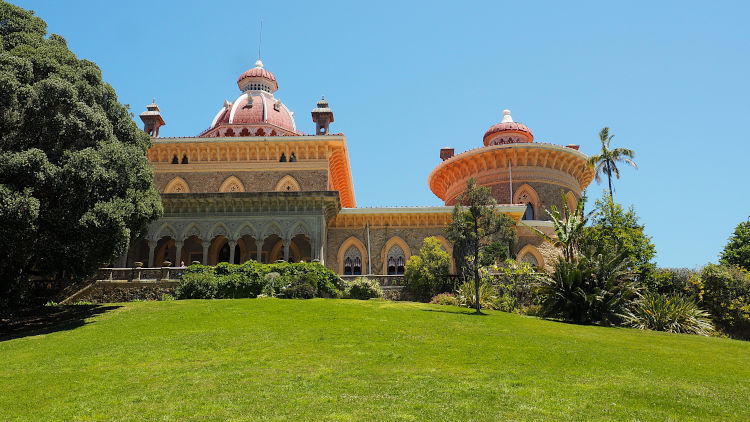
Through the rose garden and we get the first glimpse of the house sat up on top of the large green lawns. This was the first lawn planted in Portugal, and from here you can really take in the view of the parklands, and all of the interesting and beautiful trees planted here from all over the world. But your eye cannot stray far from the beauty and charm of the peach-coloured house itself.
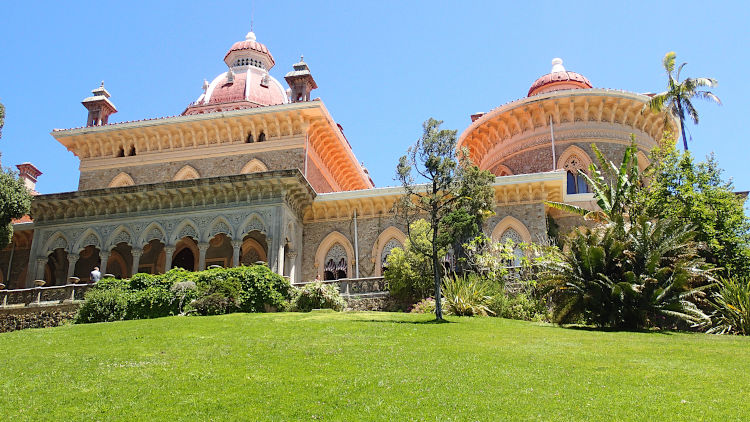
You can continue to follow the path around to the left and then climb the path and steps up to the covered terrace to admire the view of the park again, before turning to go through this door.
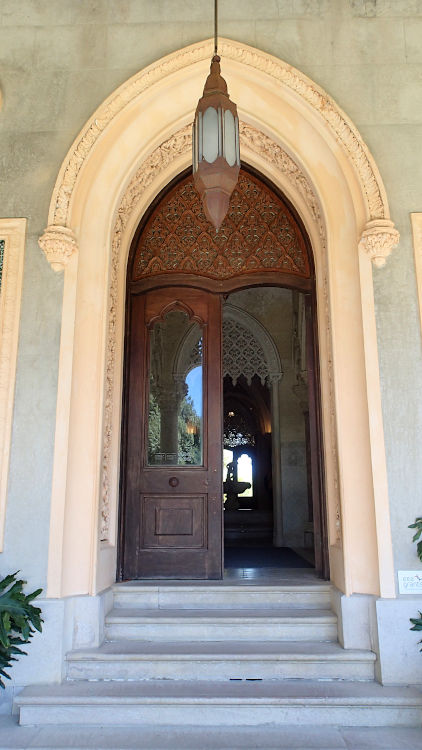
To the left a staircase which will take you up to the first floor and lots of historical information about the house, but skip that for now and walk straight through into the octagonal dome over the atrium at the very centre of the house. It was at this point Deby stopped, looked up and started to cry. If ever a house was made for her, it was this one.
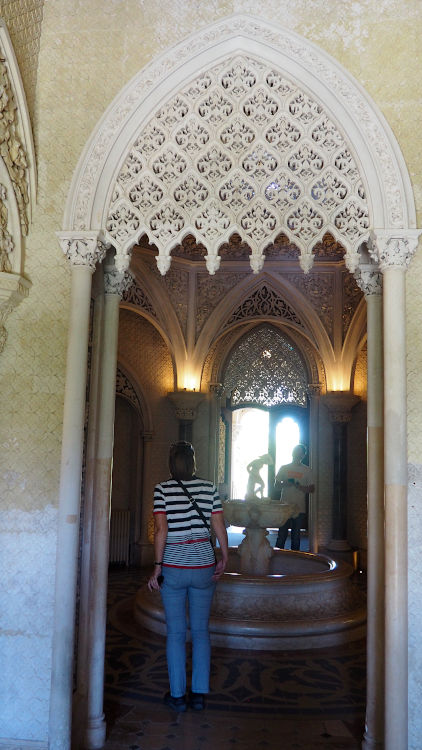
Sadly our images can never portray how beautiful this building is. Mogul style Indian Alabaster panels create pieced screens in the hall and as a balustrade in the first floor of the central tower. The main hall dome is a rich stucco-clad wood frame with fabric panels illuminated from light in the dome above. A corridor stretches the entire length of the house, connecting the three domes and the central fountain. The illusion of depth is accentuated by the series of arches and columns. In a word, this house is architectural perfection.
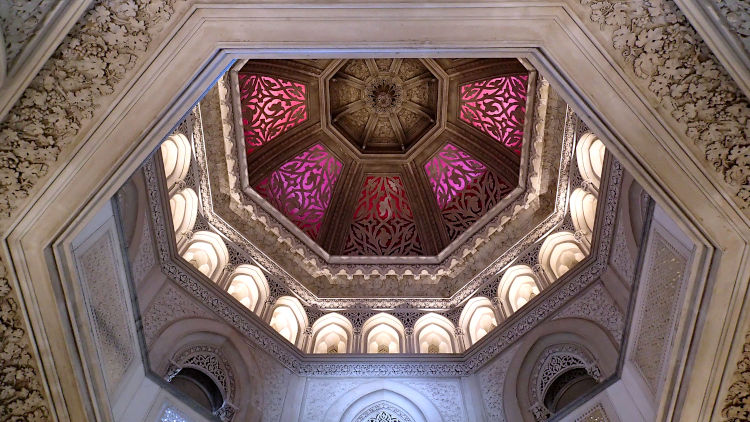
There is the most exquisite plasterwork decoration everywhere. In fact there is decoration on decoration, layer upon layer, making a striking 3D effect on every surface. The soft peach color continues in the marble columns and the paint colors in many of the rooms. The Moorish and Arabic influence creates arches, latticed panels and plasterwork of your dreams!
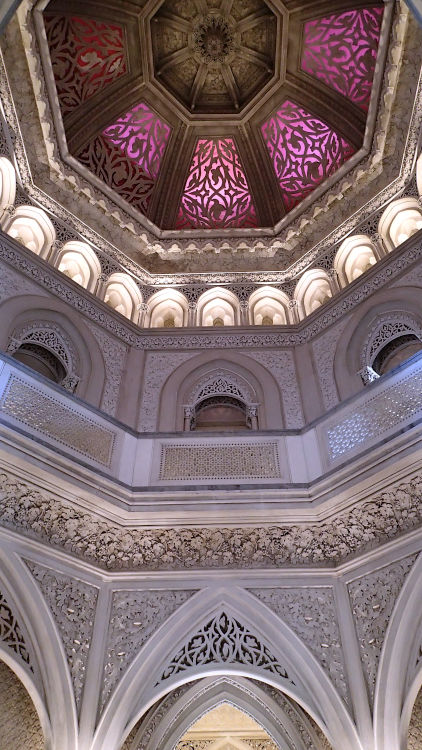
The fabulous Indian Drawing room is one of several luxurious reception rooms on the ground floor. It was restored in 2015 to the original paint colours. Here Gothic arches combine with Indian influences.
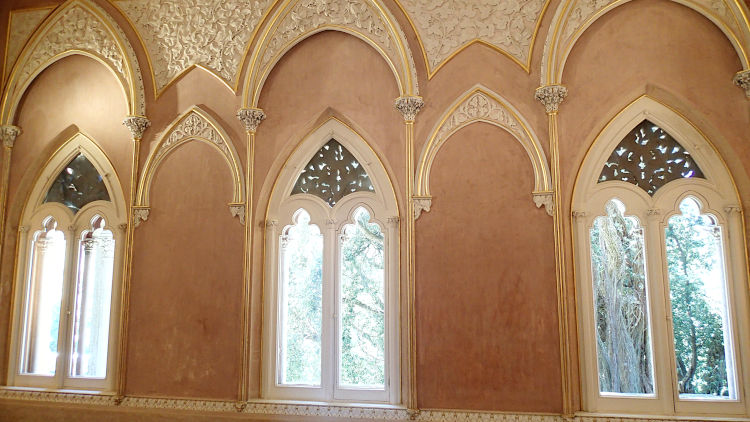
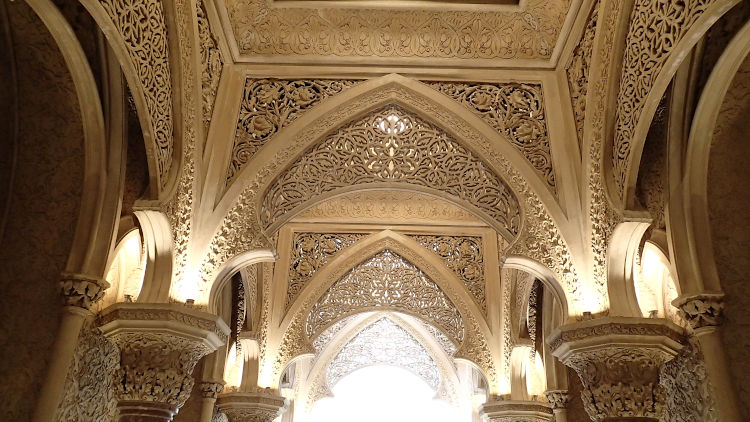
Walk down the Northern arm of the corridor past the Indian Drawing Room and the Billiards Room you’ll end up at the Music Room. It is topped by another striking domed ceiling and the walls are decorated with representations of the muses and the graces. This room can be hired for weddings and events today – OMG, if only…
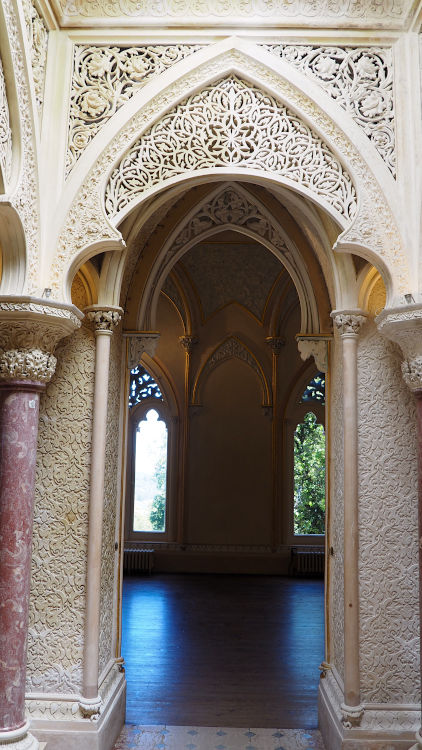
The music room has excellent acoustics and exclusively occupies the northern tower. The dome is in decorative plaster work with gilded floral motifs. It affords stunning 360-degree views of the gallery corridor and the gardens.
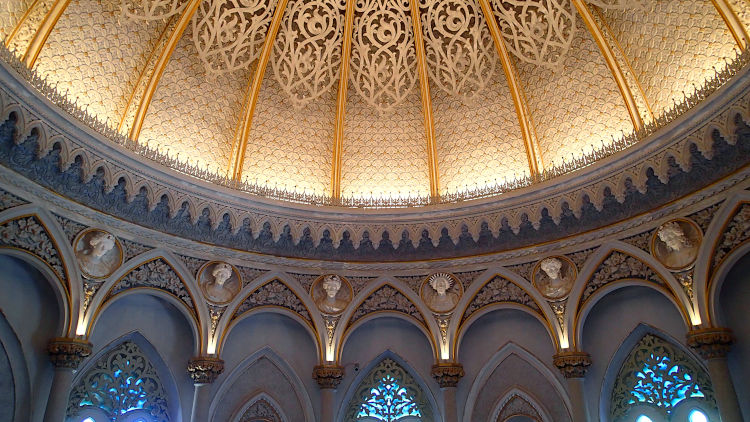
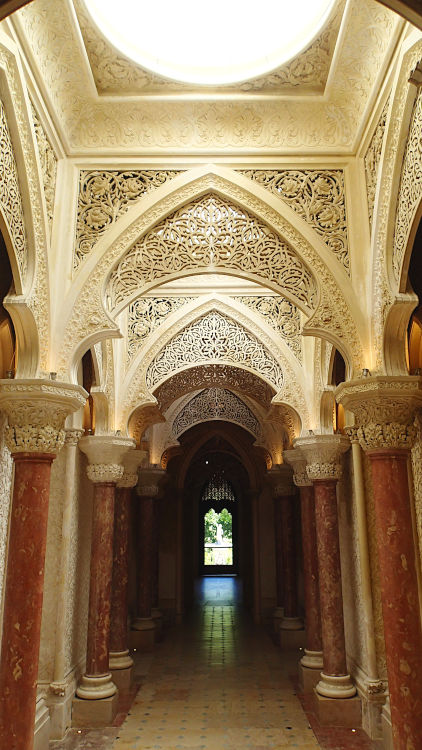
Once you have had your fill of the ground floor, climb the marble stairs decorated with an ivy leaved pattern to the top floor. Here you will get a closer view of the octagonal dome and can visit the bedrooms. At the time of our visit, Francis Cooks private chambers in the top of the south tower were closed. Not sure if this area is ever open to the public.
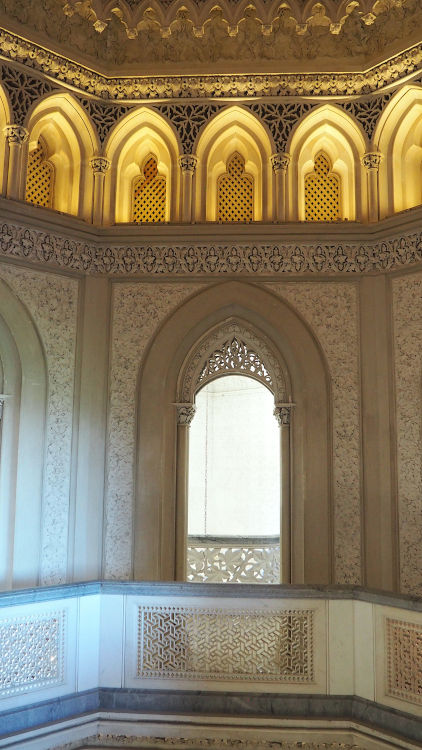
The rooms now display a short film with an interview from one of the last remaining occupants of the house, as well as information about the Cook family, the history of the house and of its restoration. These rooms are more plainly decorated than the public rooms downstairs, but still enjoy fabulous views over the park and garden, and enjoy the wonderful open space of the octagonal gallery.
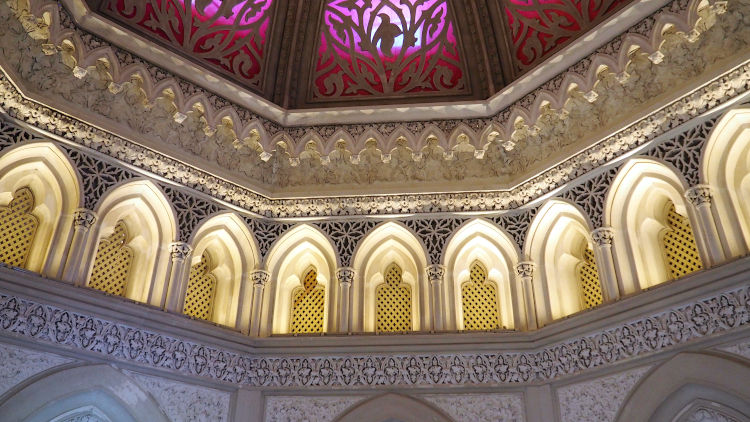
Before you leave, don’t forget to go down the stairs from the entrance hall in the south tower and check out the kitchens and pantry areas of the house. You would expect them to be underground, but because the house is built on a slope, these also open out onto the gardens on the opposite side to the lawn.
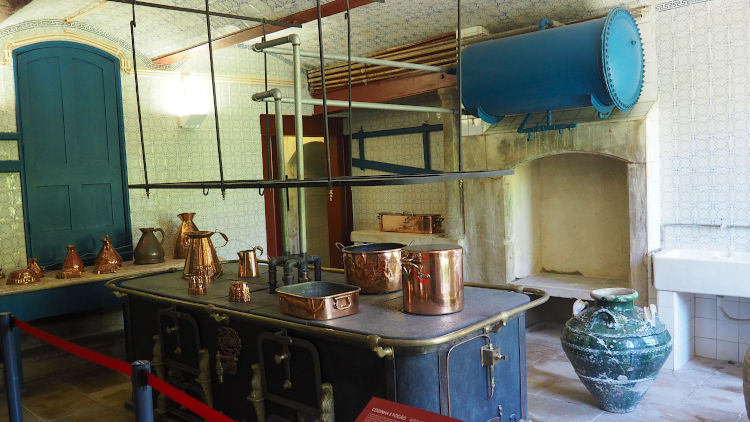

Take one more walk and lingering look along the gallery corridor before returning to the entrance hall to reluctantly exit the house. Sigh.
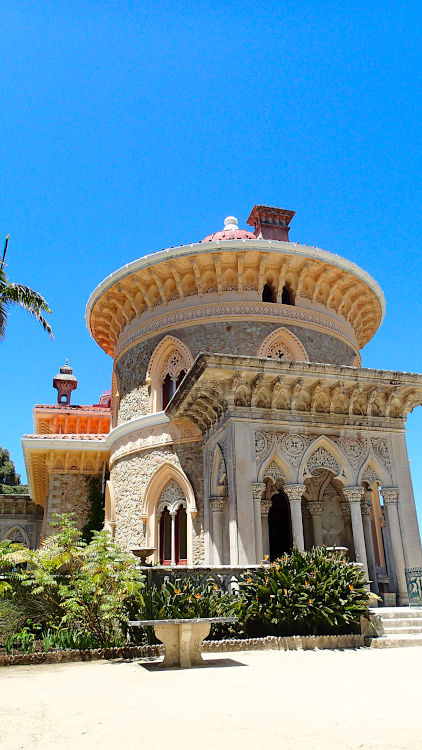
Time now to leave the house behind, climb up slowly back through the gardens and back to the road. We called an Uber to take us back to the motorhome. It was a completely EPIC couple of days and the second day, in particular, was full of delights we will never forget. If you get a chance to visit Sintra, grab it with both hands and don’t let go until you’ve seen it all.
